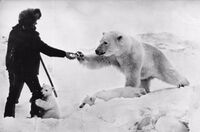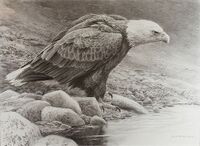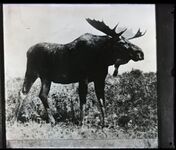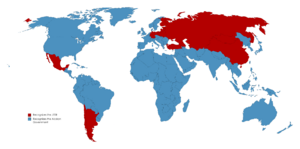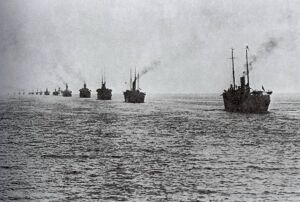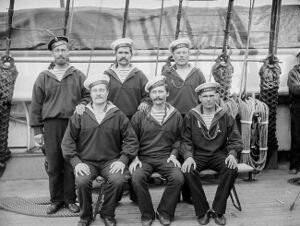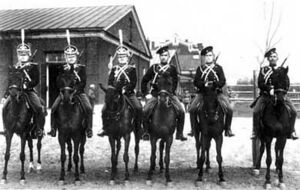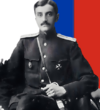Governorate of Alaska: Difference between revisions
| (33 intermediate revisions by the same user not shown) | |||
| Line 96: | Line 96: | ||
Baranov for his part had begun an affair with a native woman and had no interest in returning from Alaska. | Baranov for his part had begun an affair with a native woman and had no interest in returning from Alaska. | ||
===Russian-American Company Era=== | |||
(1799-1867) | (1799-1867) | ||
====Chief Managers of the Russian-American Company==== | |||
{| class="wikitable" style="text-align:center" | |||
|- | |||
! No. | |||
! Portrait | |||
! width=180|Name<br/>{{small|(Birth–Death)}} | |||
! Term of Office | |||
|- | |||
! | 1 | |||
| [[File:Baranov Alexandr.jpg|80px]] || [[Alexander Andreyevich Baranov]]<br/>{{small|(1747–1819)}} || July 9, 1799 – January 11, 1818<ref name=Andrews2>Andrews (1942), p. 302.</ref> | |||
|- | |||
! | 2 | |||
| [[File:Gagemester.jpg|80px]] || [[Captain (naval)|Captain]] [[Ludwig von Hagemeister]]<br/>{{small|(1780–1833)}} || January 11, 1818 – October 24, 1818<ref name=Andrews2/> | |||
|- | |||
! | 3 | |||
| [[File:Lesser Coat of Arms of Russian Empire.svg|80px]] || [[Lieutenant]] [[Semyon Yanovsky|Semyon Ivanovich Yanovsky]]<br/>{{small|(1788–1876)}}|| October 24, 1818 – September 15, 1820<ref name=Andrews2/> | |||
|- | |||
! | 4 | |||
| [[File:Muraviev Matvey Ivanovich.jpg|80px]] || [[Lieutenant]] [[Matvey Muravyev|Matvey Ivanovich Muravyev]]<br/>{{small|(1784–1826)}}|| September 15, 1820 – October 14, 1825<ref name=Andrews2/> | |||
|- | |||
! | 5 | |||
| [[File:Lesser Coat of Arms of Russian Empire.svg|80px]] || [[Pyotr Yegorovich Chistyakov]]<br/>{{small|(1790–1862)}} || October 14, 1825 – June 1, 1830<ref name=Andrews2/> | |||
|- | |||
! | 6 | |||
| [[File:Врангель Фердинанд Петрович.jpg|80px]] || [[Baron]] [[Ferdinand von Wrangel|Ferdinand Petrovich von Wrangel]]<br/>{{small|(1797–1870)}}|| June 1, 1830 – October 29, 1835<ref name=Andrews2/> | |||
|- | |||
! | 7 | |||
| [[File:Lesser Coat of Arms of Russian Empire.svg|80px]] || [[Ivan Kupreyanov|Ivan Antonovich Kupreyanov]]<br/>{{small|(1800–1857)}} || October 29, 1835 – May 25, 1840<ref name=Andrews2/> | |||
|- | |||
! | 8 | |||
| [[File:Arvid Adolf Etholén.jpg|80px]] || [[Arvid Adolf Etholén]]<br/>{{small|(1798–1876)}} || May 25, 1840 – July 9, 1845<ref name=Andrews2/> | |||
|- | |||
! | 9 | |||
| [[File:Lesser Coat of Arms of Russian Empire.svg|80px]] ||[[Vice admiral|Vice Admiral]] [[Mikhail Tebenkov|Mikhail Dmitrievich Tebenkov]]<br/>{{small|(1802–1872)}}|| July 9, 1845 – October 14, 1850<ref name=Andrews2/> | |||
|- | |||
! | 10 | |||
| [[File:Lesser Coat of Arms of Russian Empire.svg|80px]] || [[Captain (naval)|Captain]] [[Nikolay Yakovlevich Rosenberg]]<br/>{{small|(1807–1857)}} || October 14, 1850 – March 31, 1853<ref name=Andrews2/> | |||
|- | |||
! | 11 | |||
| [[File:Lesser Coat of Arms of Russian Empire.svg|80px]] ||[[Aleksandr Rudakov|Aleksandr Ilich Rudakov]]<br/>{{small|(1817–1875)}}|| March 31, 1853 – April 22, 1854<ref name=Andrews2/> | |||
|- | |||
! | 12 | |||
| [[File:Voevodskiy Stepan Vasilevich.jpg|80px]] || [[Captain (naval)|Captain]] [[Stepan Vasiliyevich Voyevodsky]]<br/>{{small|(1805–1884)}} || April 22, 1854 – June 22, 1859<ref name=Andrews2/> | |||
|- | |||
! | 13 | |||
| [[File:Hampus-Furuhjelm-1859 cropped.jpg|80px]] || [[Captain (naval)|Captain]] [[Johan Hampus Furuhjelm]]<br/>{{small|(1821–1909)}} || June 22, 1859 – December 2, 1863<ref name=Andrews2/> | |||
|- | |||
! | 14 | |||
| [[File:Dmitri P Maksutov.jpg|80px]] || Prince [[Dmitry Petrovich Maksutov|Dmitri Petrovich Maksutov]]<br/>{{small|(1832–1889)}}|| December 2, 1863 – October 18, 1867<ref name=Andrews2/> | |||
|} | |||
=====Proposed Purchase by the United States===== | |||
(1865-67) | |||
=====The Jefferson C. Davis Affair===== | |||
Davis's plans to force Russians from their homes in Novoarchangelsk leads to a scandal and upon news arriving in Russia the purchase is canceled and plans for nationalizing Russian Alaska ensue. | |||
(1867) | |||
====1867 Nationalization of the Russian American Company==== | ====1867 Nationalization of the Russian American Company==== | ||
===The Frontier Era=== | |||
(1867-1894) | |||
Commissioners of the Russian American Company post-nationalization: | |||
-Captain 2nd Rank, Aleksei Alekseyevich Peshchurov (1867-1869) (was supposed to only be there to turn over Alaska, initially frustrated but eventually shifts focus to supporting the creation of cobbled roads in downtown Novoarchangelsk | |||
-Counter Admiral Dmitry Petrovich Maksutov (1869-1874) He returns! Establishment of regulations for fishing jetties and fur trapping camps and more light houses and buoy systems are built. | |||
-Captain | |||
-Lieutenant Colonel | |||
-Commander | |||
-Colonel | |||
-Captain | |||
-Civilian | |||
-Captain (Army) | |||
===The Klondike Era=== | ===The Klondike Era=== | ||
(1896–1905) | (1896–1905) | ||
-Gold Struck | |||
-Flood of gold immigration | |||
-Attempts to stem the tide of Canadian and American immigration fail and are abandoned | |||
-Demographics rapidly change, new settlements are established | |||
Commissioners of the Russian American Company Klondike Era: | |||
-Lieutenant Colonel | |||
-Captain | |||
-Colonel | |||
-Captain (Army) | |||
-Civilian | |||
-Lieutenant-Commander | |||
===Stolypin Era=== | ===Stolypin Era=== | ||
(1905 - 1912) | (1905 - 1912) | ||
Immigration programme brings a large number of Russians, Finns, Ukrainians, Balts and others to Alaska and provides funding for agricultural, fishing and resource industry development. Novoarchangelsk and Rezanovgrad bloom | |||
Commissioners of the Russian American Company during the Stolypin Era: | |||
-Lieutenant-Commander | |||
-Civilian | |||
-Civilian | |||
-Civilian | |||
====Establishment of the Governorate of Alaska==== | ====Establishment of the Governorate of Alaska==== | ||
(1912) | (1912) | ||
===The Governorate of Alaska=== | ===The Governorate of Alaska=== | ||
Governors of Alaska prior to military government: | |||
-Governor 1: Focus on resource extraction | |||
-Governor 2: former explorer, focus on exploration, infrastructure, and the Governorate | |||
-Governor 3: Obsessed with electrification and coal extraction | |||
-Governor 4: War Effort and internal security | |||
====First World War==== | |||
(1914-1917) | |||
====Russian Civil War==== | ====Russian Civil War==== | ||
( | (1917-1923) | ||
====The Diterikhs Regime==== | ====The Diterikhs Regime==== | ||
=====The | (1921-1924) | ||
• Diterikhs sends forces from Harbin to begin creating redundancies for a withdrawal from Vladivostok (1921)<br> | |||
• Diterikhs is appointed as temporary dictator by a Zemstvo assembled in Vladivostok and officially accepts the title of Supreme Leader succeeding Kolchak two years after his death.(1922)<br> | |||
• British and Japanese naval forces escort the Imperial Army of the Far East's headquarters and reserve forces to Novoarchangelsk in preparation for an inevitable general withdrawal from Vladivostok. (1922)<br> | |||
WIP | |||
=====The May Coup===== | |||
(17 May, 1924) | |||
====The Wrangel Regime==== | ====The Wrangel Regime==== | ||
(1924-25) | |||
=====Great Reform of 1925===== | =====Great Reform of 1925===== | ||
Popular discontent with Diterikhs' regime begin to come to a head in late 1924. His autocratic style of government was unpopular with the native Russo-Alaskans, and Diterikhs' junior rank galled many of the exiled White Generals, none more than the Black Baron, Pyotr Wrangel. Assembling a diverse coalition of White Army veterans, exiled Russian liberal politicians, and outraged Russo-Alaskans and Klondikers. The date of the coup was set on the date of January 22, symbolically linking the coup with the efforts of the October Revolution of 1905. Wrangel secretly ordered the Kornilovsky Shock Regiment into the capital by night train, and on the morning of January 22, Wrangel's forces, bolstered by ad-hoc militias of locals, surrounded the main governmental offices. A tense standoff ensued, as the troops of the 1st Siberian Rifle Battalion, who were the de facto executive guards of Diterikhs, exchanged sporadic gunfire with Wrangel's troops. However, by mid-afternoon, Diterikh's position was untenable. No other units had rallied to his cause, in fact, quite the opposite. Nearly every prominent General had publicly declared for Wrangel, as well as the Ataman of the Alaskan Cossack Host. Wrangel was invited to meet with Diterikh under flag of truce, and after a brief meeting, Diterikhs' resignation was announced at 5:07. | Popular discontent with Diterikhs' regime begin to come to a head in late 1924. His autocratic style of government was unpopular with the native Russo-Alaskans, and Diterikhs' junior rank galled many of the exiled White Generals, none more than the Black Baron, Pyotr Wrangel. Assembling a diverse coalition of White Army veterans, exiled Russian liberal politicians, and outraged Russo-Alaskans and Klondikers. The date of the coup was set on the date of January 22, symbolically linking the coup with the efforts of the October Revolution of 1905. Wrangel secretly ordered the Kornilovsky Shock Regiment into the capital by night train, and on the morning of January 22, Wrangel's forces, bolstered by ad-hoc militias of locals, surrounded the main governmental offices. A tense standoff ensued, as the troops of the 1st Siberian Rifle Battalion, who were the de facto executive guards of Diterikhs, exchanged sporadic gunfire with Wrangel's troops. However, by mid-afternoon, Diterikh's position was untenable. No other units had rallied to his cause, in fact, quite the opposite. Nearly every prominent General had publicly declared for Wrangel, as well as the Ataman of the Alaskan Cossack Host. Wrangel was invited to meet with Diterikh under flag of truce, and after a brief meeting, Diterikhs' resignation was announced at 5:07. | ||
| Line 128: | Line 243: | ||
Elections for the new Duma would be held, for the first time in a Russian monarchy, under the principle of unweighted universal suffrage, and a coalition of the newly founded Constitutionalist Party (created by a merger of Kadets and Octobrists) and the Progressive Party formed the first government of the restored Russian Empire. | Elections for the new Duma would be held, for the first time in a Russian monarchy, under the principle of unweighted universal suffrage, and a coalition of the newly founded Constitutionalist Party (created by a merger of Kadets and Octobrists) and the Progressive Party formed the first government of the restored Russian Empire. | ||
====The New Governorate Era==== | |||
=====The Lvov Administration===== | |||
(1925 - 1930) | |||
• The Restoration of the Monarchy<br> | |||
• Mass Immigration<br> | |||
• Second Gold Boom<br> | |||
• Agricultural Boom<br> | |||
• Alaskan Coastal Highway Project begins in 1927.<br> | |||
• Naval Expansion Plan begins<br> | |||
• Novoarchangelsk, Rezanovgrad and Krusensternburg get modernized international airports, many towns' runways are upgraded to support massive population surges.<br> | |||
• Great Depression begins with a fizzle and then a bang<br> | |||
=====The Guchkov Administration===== | |||
(1930 - ) | |||
• Military austerity measures enacted; navy expansion put on hold. Currency is debased and small debt is taken on to provide emergency funding to farmers and fishers due to an implosion in the exports market.<br> | |||
• Free trade policies enacted, and Canadian government aid accepted to relieve food shortages, famine is narrowly averted.<br> | |||
• 1932 coal strike threatens to cripple Alaska prior to winter, negotiations lead to a labor relations board being formed by the Ministry of Internal Affairs and trinket concessions.<br> | |||
• 1933 completion of the initial Alaskan Coastal Highway project, expansion of the project is announced.<br> | |||
• January 3rd, 1934 - Holodomor Relief Act introduced.<br> | |||
==Geography== | ==Geography== | ||
| Line 243: | Line 380: | ||
|- | |- | ||
|- | |- | ||
| style="background-color:#FFBF00"| '''All-Russian Union of Patriots'''<br><small> '''Всероссийский Союз Патриотов''' | | style="background-color:#FFBF00"| <center>[[File:B.C.N..png|100px|https://iiwiki.us/wiki/All-Russian_Union_of_Patriots]]</center> <br> <center>'''All-Russian Union of Patriots'''</center><br><small> <center>'''Всероссийский Союз Патриотов'''</center> | ||
| Far-Right | | Far-Right | ||
| The All-Russian Union of Patriots or VSP is a big tent party of the far right containing a wide and fractious array of far-right political movements de-facto led by the philosopher Ivan Ilyin. The VSP can be described broadly as an anti-liberal, anti-parliamentarist party characterized by Russian nationalism and corporatism and the party is known for its staunch opposition to the Constitutional reforms of 1925. Internal factions within the VSP include the Autocrats, Fascists, National Socialists and National Syndicalists. | | The All-Russian Union of Patriots or VSP is a big tent party of the far right containing a wide and fractious array of far-right political movements de-facto led by the philosopher Ivan Ilyin. The VSP can be described broadly as an anti-liberal, anti-parliamentarist party characterized by Russian nationalism and corporatism and the party is known for its staunch opposition to the Constitutional reforms of 1925. Internal factions within the VSP include the Autocrats, Fascists, National Socialists and National Syndicalists. | ||
| Line 251: | Line 388: | ||
|- | |- | ||
|- | |- | ||
| style="background-color:#4169E1"| <span style="color:#ffffff;">'''Constitutionalist Party'''</span><br><small> <span style="color:#ffffff;">'''Конституционалистская Партия'''</span> | | style="background-color:#4169E1"| <center>[[File:Constitutionalist Party of Russia.png|100px|https://iiwiki.us/wiki/Constitutionalist_Party_of_Russia]]</center> <br> <center><span style="color:#ffffff;">'''Constitutionalist Party'''</span></center><br><small> <center> <span style="color:#ffffff;">'''Конституционалистская Партия'''</span> </center> | ||
| Center-left to center-right | | Center-left to center-right | ||
| The Constitutionalist Party is the product of a political alliance between politicians representing the right wing elements of the pre-Russian Civil War Constitutional Democratic Party or the 'Kadety' and the Union of October 17, or 'Octobrist Party'. In general, the party is known for its support of the Constitution of 1925 and espouses a political ideology characterized by constitutional monarchy and conservative liberalism. | | The Constitutionalist Party is the product of a political alliance between politicians representing the right wing elements of the pre-Russian Civil War Constitutional Democratic Party or the 'Kadety' and the Union of October 17, or 'Octobrist Party'. In general, the party is known for its support of the Constitution of 1925 and espouses a political ideology characterized by constitutional monarchy and conservative liberalism. | ||
| Line 259: | Line 396: | ||
|- | |- | ||
|- | |- | ||
| style="background-color:#C41E3A"| <span style="color:#ffffff;">'''Farmer-Labor Party'''</span><br><small><span style="color:#ffffff;">'''Фермерско-Трудовая Партия'''</span> | | style="background-color:#C41E3A"| <center>[[File:Farmer Labor Party.png|100px|https://iiwiki.us/wiki/Farmer-Labor_Party_of_Russia]]</center> <br> <center> <span style="color:#ffffff;">'''Farmer-Labor Party'''</span> </center> <br><small> <center> <span style="color:#ffffff;">'''Фермерско-Трудовая Партия'''</span> </center> | ||
| Center-left to center | | Center-left to center | ||
| The Farmer-Labor Party is a Social Democratic party advocating for social security, state control of railways and utilities, subsidies for farmers, and social liberalism. The party frames its economic program as a form of social capitalism and officially denounces communism and socialism as extreme and disproven ideologies. The party is characterized by its populism and is the center of mainstream left wing labor politics in Alaska. While the party does not officially support republicanism, there is a small, quiet republican tendency within the party's ranks. | | The Farmer-Labor Party is a Social Democratic party advocating for social security, state control of railways and utilities, subsidies for farmers, and social liberalism. The party frames its economic program as a form of social capitalism and officially denounces communism and socialism as extreme and disproven ideologies. The party is characterized by its populism and is the center of mainstream left wing labor politics in Alaska. While the party does not officially support republicanism, there is a small, quiet republican tendency within the party's ranks. | ||
| | | Dmitri Sokolov | ||
|<center>{{Infobox political party/seats|8|50|hex=#C41E3A}}</center> | |<center>{{Infobox political party/seats|8|50|hex=#C41E3A}}</center> | ||
| style="background:#D3D3D3; color:black"|<center>Opposition</center> | | style="background:#D3D3D3; color:black"|<center>Opposition</center> | ||
|- | |- | ||
|- | |- | ||
| style="background-color:#00008b"| <span style="color:#f0db41;">'''Party of Russian Pioneers and Farmers'''</span><br><small> <span style="color:#f0db41;">'''Партия Пионеров и Земледельцев России'''</span> | | style="background-color:#00008b"| <center>[[File:Flag of Party of Russian Pioneers and Farmers1.png|100px|https://iiwiki.us/wiki/Party_of_Russian_Pioneers_and_Farmers]]</center> <br> <center><span style="color:#f0db41;">'''Party of Russian Pioneers and Farmers'''</span></center><br><center><small> <span style="color:#f0db41;">'''Партия Пионеров и Земледельцев России'''</span></center> | ||
| Center to center-right | | Center to center-right | ||
| The Party of Russian Pioneers and Farmers (PP&ZR) is the party widely supported by settlers who had arrived in Alaska during and before the Stolypin Reforms and their descendants. The PP&ZR is a socially conservative Christian democratic and agrarian party. The party is catered towards the interests of those who were settled in Alaska prior to the arrival of the White Emigres and supports Farming and Fishing subsidies, infrastructural improvements to smaller towns and rural areas, protectionism and the party also has a large component which advocate for blue laws prohibiting work on Sundays and holy days. In addition to this there is a small, but significant faction within the PP&ZR which are staunch pacifists and prohibitionists. | | The Party of Russian Pioneers and Farmers (PP&ZR) is the party widely supported by settlers who had arrived in Alaska during and before the Stolypin Reforms and their descendants. The PP&ZR is a socially conservative Christian democratic and agrarian party. The party is catered towards the interests of those who were settled in Alaska prior to the arrival of the White Emigres and supports Farming and Fishing subsidies, infrastructural improvements to smaller towns and rural areas, protectionism and the party also has a large component which advocate for blue laws prohibiting work on Sundays and holy days. In addition to this there is a small, but significant faction within the PP&ZR which are staunch pacifists and prohibitionists. | ||
| Line 275: | Line 412: | ||
|- | |- | ||
|- | |- | ||
| style="background-color:#E6E6FA"| <span style="color:#914ab5;">'''Progressive Party'''</span><br><small> <span style="color:#914ab5;">'''Прогрессивная Партия'''</span> | | style="background-color:#E6E6FA"| <center>[[File:Прогрессисты.png|100px|https://iiwiki.us/wiki/Progressive_Party_of_Russia]]</center><br> <center><span style="color:#914ab5;">'''Progressive Party'''</span></center><br><center><small> <span style="color:#914ab5;">'''Прогрессивная Партия'''</span></center> | ||
| Center-left | | Center-left | ||
| The Progressive Party (PP) is a social liberal party that supports the Constitution of 1925, but advocates for greater protections of freedom of speech and press and advocates for Women's rights, minority interests and religious pluralism. The Progressive Party also supports expanding foreign trade, working with international organizations, improving labor conditions in Alaska, and opposes Communism, Socialism, Fascism and National Socialism. | | The Progressive Party (PP) is a social liberal party that supports the Constitution of 1925, but advocates for greater protections of freedom of speech and press and advocates for Women's rights, minority interests and religious pluralism. The Progressive Party also supports expanding foreign trade, working with international organizations, improving labor conditions in Alaska, and opposes Communism, Socialism, Fascism and National Socialism. | ||
| Line 305: | Line 442: | ||
====Illegal Political Movements==== | ====Illegal Political Movements==== | ||
Beginning in the late 19th century, certain political movements in Alaska have been deemed seditious due to their advocacy against Russian sovereignty in Alaska or the monarchy. Such movements have been suppressed or banned with varying degrees of strictness in enforcement. The following movements have been banned according to provisions in the Constitution of 1925: | Beginning in the late 19th century, certain political movements in Alaska have been deemed seditious due to their advocacy against Russian sovereignty in Alaska or the monarchy. Such movements have been suppressed or banned with varying degrees of strictness in enforcement. The following movements have been banned according to provisions in the Constitution of 1925: | ||
=====The | =====The American Statehood Movement===== | ||
Beginning in the 1890s amid the Klondike gold rush, a movement in favor of the American purchase or otherwise annexation of Alaska has persisted amongst some Amero-Alaskan quarters of the population. Reaching its zenith around the turn of the century, the movement was suppressed, and protests were broken up by the Alaskan Rangers. Additionally, once the influx of American settlers was offset by settlers from the Russian Empire arriving after the Stolypin Program of 1905 picked up traction in Alaska, the American statehood movement lost much of its numerical strength and Amero-Alaskans became increasingly accustomed to Russian rule. During the first world war, the governorate of Alaska declared the 'Americanist Movement' to be illegal and charged some prominent advocates of American statehood in Novoarchangelsk with sedition, though the subsequent trials concluded with the defendants pleading guilty and signing oaths of loyalty in return for paying relatively small fines. | Beginning in the 1890s amid the Klondike gold rush, a movement in favor of the American purchase or otherwise annexation of Alaska has persisted amongst some Amero-Alaskan quarters of the population. Reaching its zenith around the turn of the century, the movement was suppressed, and protests were broken up by the Alaskan Rangers. Additionally, once the influx of American settlers was offset by settlers from the Russian Empire arriving after the Stolypin Program of 1905 picked up traction in Alaska, the American statehood movement lost much of its numerical strength and Amero-Alaskans became increasingly accustomed to Russian rule. During the first world war, the governorate of Alaska declared the 'Americanist Movement' to be illegal and charged some prominent advocates of American statehood in Novoarchangelsk with sedition, though the subsequent trials concluded with the defendants pleading guilty and signing oaths of loyalty in return for paying relatively small fines. | ||
| Line 462: | Line 599: | ||
===United Kingdom=== | ===United Kingdom=== | ||
===France=== | ===France=== | ||
===Germany=== | |||
===Czech Republic=== | |||
===Italy=== | |||
===Turkey=== | |||
===Switzerland=== | ===Switzerland=== | ||
<center>[[File:Russo-Swiss Relations.jpg|250px|thumb|Switzerland and Russia have maintained continuous diplomatic relations since 1816.]]</center> | <center>[[File:Russo-Swiss Relations.jpg|250px|thumb|Switzerland and Russia have maintained continuous diplomatic relations since 1816.]]</center> | ||
Though renowned for its neutrality, Switzerland's opposition to international communism led to their recognition of the Russian Empire in exile in 1926 and financial and diplomatic ties between the two nations have grown ever since. Many prominent White Emigres settled in Switzerland after the Russian Civil War and along with anti-Communists native to Switzerland formed the basis of the [[International Entente Against the Third International]], of which many notable Russian nobles and elites in the Governorate of Alaska are active members. Indeed, Switzerland's favorable treatment of the Russian Empire in exile precedes the official recognition of the country as in 1923, after the attempted assassination of Soviet People's Commissar of Foreign Affairs Georgy Chicherin by Maurice Conradi, himself a Swiss-Russian veteran of Wrangel's Army, Conradi fled to Switzerland where he was defended by Russian-Swiss lawyer and fellow White emigre and future founder of the International Entente Against the Third International, Théodore Aubert, was acquitted of all charges and granted permission to move to the Governorate of Alaska where he rejoined the Russian Imperial Army in-exile. | Though renowned for its neutrality, Switzerland's opposition to international communism led to their recognition of the Russian Empire in exile in 1926 and financial and diplomatic ties between the two nations have grown ever since. Many prominent White Emigres settled in Switzerland after the Russian Civil War and along with anti-Communists native to Switzerland formed the basis of the [[International Entente Against the Third International]], of which many notable Russian nobles and elites in the Governorate of Alaska are active members. Indeed, Switzerland's favorable treatment of the Russian Empire in exile precedes the official recognition of the country as in 1923, after the attempted assassination of Soviet People's Commissar of Foreign Affairs Georgy Chicherin by Maurice Conradi, himself a Swiss-Russian veteran of Wrangel's Army, Conradi fled to Switzerland where he was defended by Russian-Swiss lawyer and fellow White emigre and future founder of the International Entente Against the Third International, Théodore Aubert, was acquitted of all charges and granted permission to move to the Governorate of Alaska where he rejoined the Russian Imperial Army in-exile. | ||
===Finland=== | |||
===International Recognition=== | ===International Recognition=== | ||
| Line 482: | Line 624: | ||
===Navy=== | ===Navy=== | ||
The [[Imperial Russian Navy]] was founded in 1696 and has operated as the maritime component of the Russian Armed Forces for over three centuries. During | The [[Imperial Russian Navy]] was founded in 1696 and has operated as the maritime component of the Russian Armed Forces for over three centuries. During its existence, the Imperial Russian Navy saw service in the Russo-Turkish War of 1686–1700, Great Northern War Russo-Persian War of 1722–23, Russo-Swedish War of 1741–1743, Seven Years' War, Russo-Turkish War of 1768–74, Russo-Swedish War of 1788–1790, Russo-Turkish War of 1787–92, Napoleonic Wars, Russo-Turkish War of 1828–29, Crimean War, Russo-Japanese War, World War I and the Russian Civil War. After the defeat of the White Army in Crimea in January of 1921, General Pjotr Wrangel's Fleet (officially the 'Russian Squadron') evacuated from the Black Sea through the Dardanelles and were granted safe harbor by the Third Republic of France in Bizerte, Tunisia. | ||
Russo-Persian War of 1722–23, Russo-Swedish War of 1741–1743, Seven Years' War, Russo-Turkish War of 1768–74, Russo-Swedish War of 1788–1790, Russo-Turkish War of 1787–92, Napoleonic Wars, Russo-Turkish War of 1828–29, Crimean War, Russo-Japanese War, World War I and the Russian Civil War. After the defeat of the White Army in Crimea in January of 1921, General Pjotr Wrangel's Fleet (officially the 'Russian Squadron') evacuated from the Black Sea through the Dardanelles and were granted safe harbor by the Third Republic of France in Bizerte, Tunisia. | |||
[[File:Wrangel's Departure.jpg|thumb|Wrangel's Fleet departing from Crimea c.1921]] | [[File:Wrangel's Departure.jpg|thumb|Wrangel's Fleet departing from Crimea c.1921]] | ||
Wrangel's Fleet remained docked at Bizerte until April pending repairs and several ships were scrapped to afford docking fees before the Imperial Russian Navy successfully lobbied the French and British governments to sponsor its transfer to Novoarchangelsk from which they could aid the White Army in the Russian Far East. The journey to Alaska required stops in Aden, Singapore, Hong Kong and Busan (with the special permission of the Japanese Empire) before arriving in Novoarchangelsk in late September of 1921. | Wrangel's Fleet remained docked at Bizerte until April pending repairs and several ships were scrapped to afford docking fees before the Imperial Russian Navy successfully lobbied the French and British governments to sponsor its transfer to Novoarchangelsk from which they could aid the White Army in the Russian Far East. The journey to Alaska required stops in Aden, Singapore, Hong Kong, and Busan (with the special permission of the Japanese Empire) before arriving in Novoarchangelsk in late September of 1921. | ||
Ultimately the Imperial Russian Navy could do little to stop the advance of the Red Army until they approached Vladivostok and were able to hold back the Red Army using naval support and conduct a gradual evacuation of civilians in the Russian Far East until December of 1922 when extensive ice made further naval support impossible. Naval Support was impossible until March that year and by then Vladivostok was surrounded. However, in a daring mission the Imperial Russian Navy was able to once again aid the remaining forces in Vladivostok led by General Anatoly Pepelyayev in one final push to break the siege of Vladivostok and allow for a hastened evacuation of civilians and military forces before the Red Army's final push into Vladivostok secured the city on June 16th of 1923. | Ultimately the Imperial Russian Navy could do little to stop the advance of the Red Army until they approached Vladivostok and were able to hold back the Red Army using naval support and conduct a gradual evacuation of civilians in the Russian Far East until December of 1922 when extensive ice made further naval support impossible. Naval Support was impossible until March that year and by then Vladivostok was surrounded. However, in a daring mission, the Imperial Russian Navy was able to once again aid the remaining forces in Vladivostok led by General Anatoly Pepelyayev in one final push to break the siege of Vladivostok and allow for a hastened evacuation of civilians and military forces before the Red Army's final push into Vladivostok secured the city on June 16th of 1923. | ||
After relocating to Alaska the Russian Navy was greatly aided in adjusting to its new home by the nautical charts and weather data collected over the prior decades by the Alaskan Coast Guard and set to work expanding the military ports at Novoarchangelsk and Rezanovgrad to accommodate the fleet. The large numbers of sailors initially placed a massive strain on demand for food in Alaska, however, eventually the economy adapted to the Navy's presence and businesses popped up surrounding naval bases which cater towards sailors and officers. As of 1931, the Imperial Russian Navy (IRN) is the largest military branch in the Russian Armed Forces comprising 12,567 men including officers and sailors. The Russian Imperial Navy is split between its Surface Warfare Fleet, Submarine Squadron, Naval Infantry Division and Coastal Defense Reserves (not counted in active service numbers). | After relocating to Alaska, the Russian Navy was greatly aided in adjusting to its new home by the nautical charts and weather data collected over the prior decades by the Alaskan Coast Guard and set to work expanding the military ports at Novoarchangelsk and Rezanovgrad to accommodate the fleet. The large numbers of sailors initially placed a massive strain on the demand for food in Alaska, however, eventually, the economy adapted to the Navy's presence and businesses popped up surrounding naval bases which cater towards sailors and officers. As of 1931, the Imperial Russian Navy (IRN) is the largest military branch in the Russian Armed Forces comprising 12,567 men including officers and sailors. The Russian Imperial Navy is split between its Surface Warfare Fleet, Submarine Squadron, Naval Infantry Division, and Coastal Defense Reserves (not counted in active service numbers). | ||
====Surface Warfare Fleet==== | ====Surface Warfare Fleet==== | ||
====Submarine Squadron==== | ====Submarine Squadron==== | ||
The Imperial Russian Navy Submarine Squadron is composed of four submarine vessels, the ''IRN AG-22'', ''IRN Tyulen'', ''IRN Burevestnik'' and ''IRN Utka''. All formerly a part of Wrangel's fleet, the Imperial Russian Navy Submarine Squadron fields somewhat outdated but still serviceable submarines. IRN AG-22 is an American Holland-Class submarine designed by the American-Holland torpedo boat company and built for use by the Imperial Russian Navy, whereas IRN Tyulen is a Morzh-class submarine which was constructed at Nikolayev Dockyard and IRN Burevestnik and IRN Utka are both Bars-class submarines designed by Ivan Bubnov and constructed at Nikolayev Dockyard. The Submarine Squadron has adopted the tactics of the Kriegsmarine training to operate as lone wolves and conduct targeted attacks against enemy capital and command ships. The submarines underwent maintenance and minor renovations between 1927 and 1929 before proposals to upgrade the vessels failed to gain support in the Duma. More recently there has been building support within Imperial Navy High Command for an eventual replacement of the current submarine fleet before the end of the decade, with the squadron's commander Counter Admiral Mikhail Berens stating that the current fleet is drawing dangerously to obsolescence if it is not upgraded or, preferably, replaced. | The Imperial Russian Navy Submarine Squadron is composed of four submarine vessels, the ''IRN AG-22'', ''IRN Tyulen'', ''IRN Burevestnik'' and ''IRN Utka''. All formerly a part of Wrangel's fleet, the Imperial Russian Navy Submarine Squadron fields were somewhat outdated but still serviceable submarines. IRN AG-22 is an American Holland-Class submarine designed by the American-Holland torpedo boat company and built for use by the Imperial Russian Navy, whereas IRN Tyulen is a Morzh-class submarine which was constructed at Nikolayev Dockyard and IRN Burevestnik and IRN Utka are both Bars-class submarines designed by Ivan Bubnov and constructed at Nikolayev Dockyard. The Submarine Squadron has adopted the tactics of the Kriegsmarine training to operate as lone wolves and conduct targeted attacks against enemy capital and command ships. The submarines underwent maintenance and minor renovations between 1927 and 1929 before proposals to upgrade the vessels failed to gain support in the Duma. More recently there has been building support within Imperial Navy High Command for an eventual replacement of the current submarine fleet before the end of the decade, with the squadron's commander Counter Admiral Mikhail Berens stating that the current fleet is drawing dangerously to obsolescence if it is not upgraded or, preferably, replaced. | ||
====Naval Infantry==== | ====Naval Infantry==== | ||
| Line 504: | Line 645: | ||
====Naval Academy==== | ====Naval Academy==== | ||
In 1926, facing a significant lack of junior officers funds were secured for the construction of a campus facility for the Russian Imperial Naval Academy at Novoarchangelsk. Inspired by the Kuznetsov Naval Academy in Saint Petersburg, Russia, the Novoarchangelsk facility was built to mirror the architectural design of the Neoclassical style, albeit on a smaller scale than the original. Where the Academy can claim continuity from its predecessor facility is in its senior officer corps; Mikhail Berens a former Rear Admiral of Wrangel's Fleet serving as its President since its inception. After the building's completion in 1927 the first class to graduate from the facility commissioned as officers in February of 1928. The first class of officers to begin and complete their studies at the naval academy. | In 1926, facing a significant lack of junior officers' funds were secured for the construction of a campus facility for the Russian Imperial Naval Academy at Novoarchangelsk. Inspired by the Kuznetsov Naval Academy in Saint Petersburg, Russia, the Novoarchangelsk facility was built to mirror the architectural design of the Neoclassical style, albeit on a smaller scale than the original. Where the Academy can claim continuity from its predecessor facility is in its senior officer corps; Mikhail Berens a former Rear Admiral of Wrangel's Fleet serving as its President since its inception. After the building's completion in 1927 the first class to graduate from the facility commissioned as officers in February of 1928. The first class of officers to begin and complete their studies at the naval academy. | ||
===Imperial Russian Air Service===was | |||
====Volunteer Flying Corps==== | ====Volunteer Flying Corps==== | ||
===Alaskan Home Guard=== | ===Alaskan Home Guard=== | ||
The Alaskan Home Guard includes its main force of reservists and volunteers who are regular Home Guards, the Alaskan Coast Guard which is a non-military unit responsible for search and rescue operations at sea and maintaining law and order in coastal areas and main waterways, and the Governorate Rangers who act as Alaska's Gendarmerie. At the age of 18, all males in Alaska are required to register for the selective service. Additionally, all 18 year old men except for those with academic or family exemptions or actively enrolled in a work apprenticeship are required to fulfill two years in the Alaskan Home Guard though are allowed to apply to serve in the Alaskan Coast Guard or Governorate Rangers. In addition, men without academic degrees working in fields not designated as essential to the economy can be called up for periodic reservist training (though with financial compensation) for a period of two to three years to ensure combat readiness. The selective service remains in effect until the age of 42, though in a state of war the draft can be extended to include all males under the age of 48. | The Alaskan Home Guard includes its main force of reservists and volunteers who are regular Home Guards, the Alaskan Coast Guard which is a non-military unit responsible for search and rescue operations at sea and maintaining law and order in coastal areas and main waterways, and the Governorate Rangers who act as Alaska's Gendarmerie. At the age of 18, all males in Alaska are required to register for the selective service. Additionally, all 18-year-old men except for those with academic or family exemptions or actively enrolled in a work apprenticeship are required to fulfill two years in the Alaskan Home Guard though are allowed to apply to serve in the Alaskan Coast Guard or Governorate Rangers. In addition, men without academic degrees working in fields not designated as essential to the economy can be called up for periodic reservist training (though with financial compensation) for a period of two to three years to ensure combat readiness. The selective service remains in effect until the age of 42, though in a state of war the draft can be extended to include all males under the age of 48. | ||
====Alaskan Coast Guard==== | ====Alaskan Coast Guard==== | ||
The Alaskan Coast Guard began as a collection of free volunteers operating lifeguard stations and rescue vessels during the 1870s as fur trapping brought more pioneers to the Alaskan peninsula. Eventually the Coast Guard was organized into a unified authority during the Dmitry Petrovich Maksutov administration, though it was composed entirely of free volunteers occasionally with the assistance of vessels from the Imperial Russian Navy. Eventually, the Coast Guard was made subordinate to the highest ranking admiral stationed at Novoarchangelsk in an arrangement that lasted until 1925 when the Coast Guard was transferred to be overseen by civilian local government. | The Alaskan Coast Guard began as a collection of free volunteers operating lifeguard stations and rescue vessels during the 1870s as fur trapping brought more pioneers to the Alaskan peninsula. Eventually the Coast Guard was organized into a unified authority during the Dmitry Petrovich Maksutov administration, though it was composed entirely of free volunteers occasionally with the assistance of vessels from the Imperial Russian Navy. Eventually, the Coast Guard was made subordinate to the highest-ranking admiral stationed at Novoarchangelsk in an arrangement that lasted until 1925 when the Coast Guard was transferred to be overseen by civilian local government. | ||
[[File:Coast Guard Alaska.jpg|thumb|Alaskan Coast Guard c.1925 prior to their separation from Imperial Russian Navy]] | [[File:Coast Guard Alaska.jpg|thumb|Alaskan Coast Guard c.1925 prior to their separation from Imperial Russian Navy]] | ||
As of 1931, the Coast Guard is the chief maritime component of the Alaskan Home Guard and operates many of the lighthouses and rescue stations across the Alaskan coastline. The Coast Guard is not considered to be a military unit as their operations in coastal law enforcement and search and rescue | As of 1931, the Coast Guard is the chief maritime component of the Alaskan Home Guard and operates many of the lighthouses and rescue stations across the Alaskan coastline. The Coast Guard is not considered to be a military unit as their operations in coastal law enforcement and search and rescue are critical to the wellbeing of Alaskan society and therefore active-duty Coast Guard sailors are exempted from combat roles. Additionally, the Coast Guard interdicts illegally imported goods, operates radio jamming stations which block Soviet Propaganda from being broadcasted to the Aleutian Islands. | ||
====Governorate Rangers==== | ====Governorate Rangers==== | ||
In 1827, the Special Corps of Gendarmes was established in the Russian empire as a military force with law enforcement duties among the civilian population responsible to each respective Governorate. After the nationalization of the Russian American Company in 1867, security needs of fur trappers, settlers and integrated natives required the establishment of such a body in the Alaska territory and in 1874 the Alaskan Rangers were founded under the Dmitry Petrovich Maksutov administration. The Alaskan Rangers had similar powers to the Special Corps of Gendarmes though these powers were more extensive due to the Alaskan territory being under military rule. Nonetheless, the Alaskan Rangers in effect acted similarly to Canada's North-West Mounted Police which was established a year earlier and primarily served as a regional police force, a check on native particularism and, starting in the 1880s, as a protection force for railroad construction workers. | In 1827, the Special Corps of Gendarmes was established in the Russian empire as a military force with law enforcement duties among the civilian population responsible to each respective Governorate. After the nationalization of the Russian American Company in 1867, the security needs of fur trappers, settlers and integrated natives required the establishment of such a body in the Alaska territory and in 1874 the Alaskan Rangers were founded under the Dmitry Petrovich Maksutov administration. The Alaskan Rangers had similar powers to the Special Corps of Gendarmes though these powers were more extensive due to the Alaskan territory being under military rule. Nonetheless, the Alaskan Rangers in effect acted similarly to Canada's North-West Mounted Police which was established a year earlier and primarily served as a regional police force, a check on native particularism and, starting in the 1880s, as a protection force for railroad construction workers. | ||
[[File:Governorate Rangers.jpg|thumb|The Governorate Rangers c.1928]] | [[File:Governorate Rangers.jpg|thumb|The Governorate Rangers c.1928]] | ||
| Line 528: | Line 670: | ||
With the coming of the discovery of gold in Alaska and the succeeding Klondike Gold Rush the Alaskan Rangers were tasked with managing the massive influx of primarily American and Canadian prospectors and those that followed to cater businesses towards them. In 1897, the Alaskan Rangers were instrumental in carefully but forcefully shutting down a massive protest for Alaskan annexation by the United States in Rezanovgrad that threatened to overrun city authorities. Hundreds of Americans were arrested and deported, though some were allowed to stay in the territory in return for paying a fine and signing an oath to follow Russian law and refrain from seditious activities known as the Loyalty Bargain of 1897. | With the coming of the discovery of gold in Alaska and the succeeding Klondike Gold Rush the Alaskan Rangers were tasked with managing the massive influx of primarily American and Canadian prospectors and those that followed to cater businesses towards them. In 1897, the Alaskan Rangers were instrumental in carefully but forcefully shutting down a massive protest for Alaskan annexation by the United States in Rezanovgrad that threatened to overrun city authorities. Hundreds of Americans were arrested and deported, though some were allowed to stay in the territory in return for paying a fine and signing an oath to follow Russian law and refrain from seditious activities known as the Loyalty Bargain of 1897. | ||
As the Stolypin reforms began in 1905, a wave of thousands of new | As the Stolypin reforms began in 1905, a wave of thousands of new Russians, Ukrainians and Finns arrived in the Alaskan territory and the Alaskan Rangers were reformed to have a metropolitan and territorial division. The metropolitan division was to be specialized for urban areas defined as having at least one thousand permanent residents while the territorial rangers were primarily tasked with handling native affairs and the protection of the gradually expanding railway system. | ||
After the Russian Civil War, the Russian government and over one hundred thousand White Emigres relocated to Alaska. As the population rapidly expanded throughout the 1920s it became clear that government reform was long overdue. Locally, towns and farming regions had been granted formal local civilian government as early as the 1870s however the region as a whole had been under military rule. After the Governorate of Alaska was established in 1925, the Alaskan Rangers were transferred from military oversight to civilian oversight by the Governorate of Alaska and re-designated as the Governorate Rangers. Over the course of the late 1920s as more towns adopted their own local police forces the metropolitan rangers have been increasingly confined to operating in frontier towns while the territorial rangers still continue their crucial work engaging in native relations and railway security. | After the Russian Civil War, the Russian government and over one hundred thousand White Emigres relocated to Alaska. As the population rapidly expanded throughout the 1920s it became clear that government reform was long overdue. Locally, towns and farming regions had been granted formal local civilian government as early as the 1870s however the region as a whole had been under military rule. After the Governorate of Alaska was established in 1925, the Alaskan Rangers were transferred from military oversight to civilian oversight by the Governorate of Alaska and re-designated as the Governorate Rangers. Over the course of the late 1920s as more towns adopted their own local police forces, the metropolitan rangers have been increasingly confined to operating in frontier towns while the territorial rangers still continue their crucial work engaging in native relations and railway security. | ||
===Equipment=== | ===Equipment=== | ||
| Line 816: | Line 958: | ||
| {{bulleted list |''IRN Burevestnik'' | ''IRN Utka''}} | | {{bulleted list |''IRN Burevestnik'' | ''IRN Utka''}} | ||
| Each hosts a complement of 33. | | Each hosts a complement of 33. | ||
|- | |- | ||
! style="align: center; background: lavender;" colspan="7" | '''Command and Replenishment Ships''' | ! style="align: center; background: lavender;" colspan="7" | '''Command and Replenishment Ships''' | ||
| Line 890: | Line 1,022: | ||
| ''IRN Vsadnik'' | | ''IRN Vsadnik'' | ||
| Hosts a complement of 35. | | Hosts a complement of 35. | ||
|- | |- | ||
! style="align: center; background: lavender;" colspan="7" | '''Training Ships''' | ! style="align: center; background: lavender;" colspan="7" | '''Training Ships''' | ||
| Line 940: | Line 1,062: | ||
| [[Sikorsky VS-37B "Strazh"]] | | [[Sikorsky VS-37B "Strazh"]] | ||
| [[File:Sikorsky-Consolidated S-37-2 aircraft.jpg|200px]] | | [[File:Sikorsky-Consolidated S-37-2 aircraft.jpg|200px]] | ||
| {{flagicon image|Flag of Russian Alaska.png}} [[Alaska]] | | {{flagicon image|Flag of Russian Alaska.png}} [[Governorate of Alaska|Alaska]] | ||
| Bomber | | Bomber | ||
| 27 | | 27 | ||
| Line 947: | Line 1,069: | ||
| [[Sikorsky R.S.]] | | [[Sikorsky R.S.]] | ||
| [[File:Russian Naval Plane.png|200px]] | | [[File:Russian Naval Plane.png|200px]] | ||
| {{flagicon image|Flag of Russian Alaska.png}} [[Alaska]] | | {{flagicon image|Flag of Russian Alaska.png}} [[Governorate of Alaska|Alaska]] | ||
| Flying Boat | | Flying Boat | ||
| 22 | | 22 | ||
| In active service, introduced in 1928 and in active production | | In active service, introduced in 1928 and in active production | ||
|- | |||
| [[Nieuport 21]] | |||
| [[File:Nieuport 10 colourized.jpg|200px]] | |||
| {{flagicon image|Flag of France (1794–1815, 1830–1958).svg}} France | |||
| Recon | |||
| 9 | |||
| Primarily used as trainer planes. | |||
|- | |||
| [[Lebed XIII]] | |||
| [[File:Lebeď XII (Rossia).jpg|200px]] | |||
| {{flagicon image|Flag of Russia.svg}} [[Russia]] <br> {{flagicon image|Flag of Russian Alaska.png}} [[Governorate of Alaska|Alaska]] | |||
| Recon | |||
| 41 | |||
| In active service. | |||
|- | |- | ||
|} | |} | ||
| Line 956: | Line 1,092: | ||
==Demographics== | ==Demographics== | ||
===Ethnic Groups=== | ===Ethnic Groups=== | ||
Alaska is comprised of people of many varying ethnicities | Alaska is comprised of people of many varying ethnicities. In the 1930 census, listed ethnic groups included: | ||
• Russians <br> | • Russians <br> | ||
| Line 983: | Line 1,119: | ||
===Agriculture=== | ===Agriculture=== | ||
Much of Alaska's | Much of Alaska's food stock is provided by foreign aid from the United States of America, Canada, and to a limited extent Japan. Private donations also make up a significant part of this aid. | ||
Domestic production is limited due to the limited arable land available to farmers - the vast majority of food production is performed to the southern-most portions of Alaska, particularly around Rezanovgrad. Fishing is also a major portion of the industry. | Domestic production is limited due to the limited arable land available to farmers - the vast majority of food production is performed to the southern-most portions of Alaska, particularly around Rezanovgrad. Fishing is also a major portion of the industry. | ||
Agriculture is diversified during the | Agriculture is diversified during the summer regions - Corn, cucumbers, and tomatoes are examples of some Summer-only crops. The Summer also marks a significant increase in foodstuff production. Year-round crops include potatoes, cauliflower, cabbage, turnips, broccoli, kohlrabi, barley, hay, oats, and brussels sprouts. | ||
===Organized Labor=== | ===Organized Labor=== | ||
| Line 1,023: | Line 1,159: | ||
===Sports=== | ===Sports=== | ||
====American Football==== | ====American Football==== | ||
[[File:Football 1920.png|thumb|University of Rezanovgrad Black Knights c.1929]] | |||
First introduced to the Alaskan peninsula by Klondikers from the American west coast, American Football grew further in popularity among the Stolypin Era settlers of Novoarchangelsk and Rezanovgrad and, while still limited in scale, the University of Rezanovgrad, the University of Alaska at Krusensternburg, Imperial Academy of the Arts and Sciences at Novoarchangelsk, the University of Novoarchangelsk, the American University at Novoarchangelsk, Polar College at Baranovsk, and Wrangel College at Wrangelgrad each feature college football teams and organize matches between one another. | First introduced to the Alaskan peninsula by Klondikers from the American west coast, American Football grew further in popularity among the Stolypin Era settlers of Novoarchangelsk and Rezanovgrad and, while still limited in scale, the University of Rezanovgrad, the University of Alaska at Krusensternburg, Imperial Academy of the Arts and Sciences at Novoarchangelsk, the University of Novoarchangelsk, the American University at Novoarchangelsk, Polar College at Baranovsk, and Wrangel College at Wrangelgrad each feature college football teams and organize matches between one another. | ||
| Line 1,030: | Line 1,169: | ||
====Baseball==== | ====Baseball==== | ||
====Wrestling==== | ====Wrestling==== | ||
==== | ====Mushing==== | ||
Sled dogs have been used to pull sleds since at least 6000 BC. Dog sleds and harnesses were discovered in Siberia with dog remains carbon-dated to 7800-8000 years old. Dogs were often used to pull loads in Native American cultures and thus dog sledding in Alaska began as a matter of practicality. | |||
Russian settlers had forgone the use of dog sleds and instead used imported Siberian ponies for transportation, as dog sledding was seen as archaic and an inferior mode of transportation. However, during the Klondike, Canadian settlers from Quebec who had adopted the practice during the 17th century brought this skill with them and, after arriving in Alaska in the 1890s became the first Europeans in Alaska to use dog sleds as a primary mode of transportation. American settlers and Stolypin Era pioneers soon began to adopt the practice. The rising popularity of dog sledding was further boosted in 1911, Norwegian explorer Roald Amundsen successfully used sled dogs in a race to become the first person to reach the South Pole. Finally, in 1925, dog sledding ascended to legendary status after Baranovsk and surrounding areas, plagued by diptheria, faced a blizzard that prevented the air delivery of a life-saving serum to Baranovsk airport. Determined to deliver much-needed medicine, the Alaskan Ministry of Internal Affairs dispatched a team of dog sledders who, in a long 1,085 km perilous journey, managed to deliver the medicine within 5 ½ days. | |||
The Iditarod was a landmark event in Alaskan history, with the lead dog of the dog sled team Balto and his musher Gunnar Kaasen both being recognized by Chairman Pyotr Wrangel of the Provisional Government. Kaasen was inducted into the Order of Saint Alexander Nevsky, and a statue depicting Kaasen and Balto were later erected in Novoarchangelsk and Baranovsk. | |||
(WIP) | |||
===Cultural Symbols & Icons=== | ===Cultural Symbols & Icons=== | ||
Latest revision as of 00:52, 5 December 2022
This article is incomplete because it is pending further input from participants, or it is a work-in-progress by one author. Please comment on this article's talk page to share your input, comments and questions. Note: To contribute to this article, you may need to seek help from the author(s) of this page. |
Governorate of Alaska Губе́рния Аляска | |
|---|---|
Motto: Always faithful "Всегда верный" | |
| Map of Alaska Map of Alaska | |
| Capital | Novoarchangelsk "Новоархангельск" |
| Largest city | Rezanovgrad "Резановград" |
| Official languages | Russian |
| Ethnic groups | Russians (36.8%), Amero-Alaskans (23.4%), Native Alaskans (11.5%), Finns (6.6%), Cossacks (6.1%), Japanese (3.8%), Canadian-Alaskans (3.2%), Yakuts (3.1%), Filipino (1.8%), Baltic Germans (1.7%), Volga Germans (1.5%), Other (0.5%) |
| Demonym(s) | Alaskan |
| Government | Constitutional Monarchy |
• Sovereign | Roman Petrovich Romanov |
• Governor | Alexander Guchkov |
| Legislature | Legislature |
| Council of State | |
| Duma | |
| History | |
• WIP | 1900 |
• WIP | 1931 |
| Area | |
• | 663,268 sq mi (1,717,860 km2) |
• Water (%) | 13.77 |
| Population | |
• 1930 estimate | 299,674 |
| Currency | Alaskan Ruble (₽) (ARB) |
| Time zone | UTC-8 (ADT) |
| Driving side | right |
Alaska, officially the Governorate of Alaska ((Russian: Губе́рния Аляска), is a sovereign nation located in North America. Alaska is bordered by the Dominion of Canada to her east and shares the Bering Strait with The Union of Soviet Socialist Republics (USSR) to her west.
The population of the country is distributed throughout its main cities and vast rural regions. The most populous cities are the Rezanovgrad followed by Novoarchangelsk and Krusensternburg. The Alaskan hinterland in the northern regions have small settlements scattered throughout the various mountainous and forested tundra regions. Aside from these, much of Alaska is rural and marked by large national reserves and mining zones.
Alaska is a constitutional monarchy with its capital located in Novoarchangelsk, the second largest city in the country which serves as cultural and commercial centers. The largest city in Alaska is Rezanovgrad. Alaska has a separation of powers between its Executive, Judicial and Legislative branches.
History
Pre-history
The earliest human settlements in Alaska originate from the late Paleolithic period when people crossed the Bering Isthmus, which joins Eurasia and America into one continent. According to several estimates, this event occurred roughly twenty thousand years ago. A large ice sheet that persisted until the end of the Wisconsin glacial period slowed the settlers' journey into the region's depths (the last ice age on the mainland). Following this period, people went to what is now modern-day Canada and established a presence across North America. Thereafter, the Eskimos and other indigenous peoples made Alaska their home. Later, newcomers arrived as part of the slave trade in the Pacific Northwest, trading slaves for copper, blankets, dogs, and goat hair. The Tlingits were the most numerous of these peoples residing in Alaska.
Exploration and Early Settlement
Alaska was first discovered by European powers by the Imperial Russian Navy commander of Danish heritage, Vitus Bering and Imperial Russian Navy Captain Aleksei Chirikov during the Great Northern Expedition. The expedition, conceived by Tsar Peter 'the Great' and executed by Tsarinas' Anna and Elizabeth, aimed to assess the truth of rumors that either a land bridge or narrow strait existed between the recently mapped Kamchatka region and North America. The expedition cost roughly one-sixth of the 1724 Russian government budget and came to fruition in 1741 when Captain Chirikov and his crew for their part discovered the coast of North America proper, sighting an island in the Alexander Archipelago which was later named in his honor as well as the second-largest mountain in Alaska Mount Saint Elias. On their return journey, the fleets encountered heavy storms which caused the fleet to split. Bering and his crew of 29 men shipwrecked on the westernmost island of the Commander Islands chain and ultimately Bering succumbed to scurvy while on the island which along with the strait it is located in was named in his honor. Much of Bering's crew survived due to the heroic actions of Swedish-born Imperial Russian Navy lieutenant Sven Waxell and were subsequently rescued after ten months of living off of seals, birds, and seaweed. After their return to Russia in 1742 their reports about the quality pelts of seals in the Bering strait triggered the first early waves of Russian activity off the coast of Alaska.
By the late 18th century, the fur trade came to be dominated by the Shelikhov-Golikov Company which established several prominent trading posts for fur trappers along with the Aleutian islands including the prominent Three Saints Bay outpost located near modern-day Pavlovskaya on Kodiak Island in 1783. The Shelikhov-Golikov Company relied heavily on indentured servant labor and on the practice of taking hostages from native Aleut tribes in exchange for ransoms in the form of fur hides. This practice led to tense relations between the company and Aleut tribes and the natives of Kodiak island fled to Awa'uq island. In reaction, Shelikhov himself led a militia primarily composed of promyshlennikis and a compliment of the company's Russian cannoneers. Shelikhov pursued the natives who refused to return to Pavlovskaya and subsequently Shelikhov, in a fit of frustration and a bid to display strength gave an order to fire on the natives. The resulting affair was the Awa'uq massacre in which thousands of natives were killed and hundreds more were detained as hostages. While this action succeeded in subjugating the tribe and forcing other Aleuts into submission, it also spelled the end of Shelikhov's time as chief manager of the Shelikhov-Golikov Company as he opted to return to representing the company in Russia. Shelikhov briefly appointed Konstantin Alekseevich Samoilov as his successor before settling on Evstratii Delarov, a Greek man originally from Epirus.
Delarov's time as chief manager was marked by an acceleration in fur yields and increased attention for the company's efforts back in Russia. During Delarov's time as chief manager, in 1788, he was contacted in person by Spanish explorer Gonzalo López de Haro who was conducting a Spanish expedition in the Pacific Northwest. In the meeting, Delarov asserted Russia's intentions of populating trading posts as far south as the Nootka Sound. Though initially successful in impressing the Russians' capability and presence upon the Spanish, Delarov's exaggerations of Russia's presence in the region became clear after he claimed that 120 Russians resided in Unalaska. The Spanish decided to investigate this claim and visit the town where they discovered that there was, in fact, only one Russian residing in Unalaska while the remainder of the population was Aleut. In 1791, Delarov was transferred to St. Petersburg and a new chief manager, Alexander Andreyevich Baranov, was selected.
Baranov's first order of business was relocating the center of operations from the constrained Three Saints Bay outpost to Pavlovskaya in 1792. After this Baranov initiated a series of developments that concluded in the establishment of the Russian-American Company. In 1794, Baranov established an outpost at Voskresenskii to alleviate logistical problems relating to the transportation of goods gathered on Kodiak island which was operated by a British captain working for the Russian-American Company and the same year representatives of the Russian Orthodox Church arrived in Pavlovskaya. The clergy began the work of proselytizing and bringing comfort to the Russian Orthodox faithful in the region, though they took issue with Baranov and the company's practices regarding their treatment of natives. In 1795 Baranov oversaw the settlement of thirty Russian serf families and...
...
Baranov for his part had begun an affair with a native woman and had no interest in returning from Alaska.
Russian-American Company Era
(1799-1867)
Chief Managers of the Russian-American Company
| No. | Portrait | Name (Birth–Death) |
Term of Office |
|---|---|---|---|
| 1 |  |
Alexander Andreyevich Baranov (1747–1819) |
July 9, 1799 – January 11, 1818[1] |
| 2 |  |
Captain Ludwig von Hagemeister (1780–1833) |
January 11, 1818 – October 24, 1818[1] |
| 3 | Lieutenant Semyon Ivanovich Yanovsky (1788–1876) |
October 24, 1818 – September 15, 1820[1] | |
| 4 |  |
Lieutenant Matvey Ivanovich Muravyev (1784–1826) |
September 15, 1820 – October 14, 1825[1] |
| 5 | Pyotr Yegorovich Chistyakov (1790–1862) |
October 14, 1825 – June 1, 1830[1] | |
| 6 |  |
Baron Ferdinand Petrovich von Wrangel (1797–1870) |
June 1, 1830 – October 29, 1835[1] |
| 7 | Ivan Antonovich Kupreyanov (1800–1857) |
October 29, 1835 – May 25, 1840[1] | |
| 8 |  |
Arvid Adolf Etholén (1798–1876) |
May 25, 1840 – July 9, 1845[1] |
| 9 | Vice Admiral Mikhail Dmitrievich Tebenkov (1802–1872) |
July 9, 1845 – October 14, 1850[1] | |
| 10 | Captain Nikolay Yakovlevich Rosenberg (1807–1857) |
October 14, 1850 – March 31, 1853[1] | |
| 11 | Aleksandr Ilich Rudakov (1817–1875) |
March 31, 1853 – April 22, 1854[1] | |
| 12 |  |
Captain Stepan Vasiliyevich Voyevodsky (1805–1884) |
April 22, 1854 – June 22, 1859[1] |
| 13 |  |
Captain Johan Hampus Furuhjelm (1821–1909) |
June 22, 1859 – December 2, 1863[1] |
| 14 |  |
Prince Dmitri Petrovich Maksutov (1832–1889) |
December 2, 1863 – October 18, 1867[1] |
Proposed Purchase by the United States
(1865-67)
The Jefferson C. Davis Affair
Davis's plans to force Russians from their homes in Novoarchangelsk leads to a scandal and upon news arriving in Russia the purchase is canceled and plans for nationalizing Russian Alaska ensue. (1867)
1867 Nationalization of the Russian American Company
The Frontier Era
(1867-1894) Commissioners of the Russian American Company post-nationalization:
-Captain 2nd Rank, Aleksei Alekseyevich Peshchurov (1867-1869) (was supposed to only be there to turn over Alaska, initially frustrated but eventually shifts focus to supporting the creation of cobbled roads in downtown Novoarchangelsk -Counter Admiral Dmitry Petrovich Maksutov (1869-1874) He returns! Establishment of regulations for fishing jetties and fur trapping camps and more light houses and buoy systems are built. -Captain -Lieutenant Colonel -Commander -Colonel -Captain -Civilian -Captain (Army)
The Klondike Era
(1896–1905)
-Gold Struck -Flood of gold immigration -Attempts to stem the tide of Canadian and American immigration fail and are abandoned -Demographics rapidly change, new settlements are established
Commissioners of the Russian American Company Klondike Era:
-Lieutenant Colonel -Captain -Colonel -Captain (Army) -Civilian -Lieutenant-Commander
Stolypin Era
(1905 - 1912)
Immigration programme brings a large number of Russians, Finns, Ukrainians, Balts and others to Alaska and provides funding for agricultural, fishing and resource industry development. Novoarchangelsk and Rezanovgrad bloom
Commissioners of the Russian American Company during the Stolypin Era:
-Lieutenant-Commander -Civilian -Civilian -Civilian
Establishment of the Governorate of Alaska
(1912)
The Governorate of Alaska
Governors of Alaska prior to military government:
-Governor 1: Focus on resource extraction -Governor 2: former explorer, focus on exploration, infrastructure, and the Governorate -Governor 3: Obsessed with electrification and coal extraction -Governor 4: War Effort and internal security
First World War
(1914-1917)
Russian Civil War
(1917-1923)
The Diterikhs Regime
(1921-1924)
• Diterikhs sends forces from Harbin to begin creating redundancies for a withdrawal from Vladivostok (1921)
• Diterikhs is appointed as temporary dictator by a Zemstvo assembled in Vladivostok and officially accepts the title of Supreme Leader succeeding Kolchak two years after his death.(1922)
• British and Japanese naval forces escort the Imperial Army of the Far East's headquarters and reserve forces to Novoarchangelsk in preparation for an inevitable general withdrawal from Vladivostok. (1922)
WIP
The May Coup
(17 May, 1924)
The Wrangel Regime
(1924-25)
Great Reform of 1925
Popular discontent with Diterikhs' regime begin to come to a head in late 1924. His autocratic style of government was unpopular with the native Russo-Alaskans, and Diterikhs' junior rank galled many of the exiled White Generals, none more than the Black Baron, Pyotr Wrangel. Assembling a diverse coalition of White Army veterans, exiled Russian liberal politicians, and outraged Russo-Alaskans and Klondikers. The date of the coup was set on the date of January 22, symbolically linking the coup with the efforts of the October Revolution of 1905. Wrangel secretly ordered the Kornilovsky Shock Regiment into the capital by night train, and on the morning of January 22, Wrangel's forces, bolstered by ad-hoc militias of locals, surrounded the main governmental offices. A tense standoff ensued, as the troops of the 1st Siberian Rifle Battalion, who were the de facto executive guards of Diterikhs, exchanged sporadic gunfire with Wrangel's troops. However, by mid-afternoon, Diterikh's position was untenable. No other units had rallied to his cause, in fact, quite the opposite. Nearly every prominent General had publicly declared for Wrangel, as well as the Ataman of the Alaskan Cossack Host. Wrangel was invited to meet with Diterikh under flag of truce, and after a brief meeting, Diterikhs' resignation was announced at 5:07.
A joint military-civilian commission was established to draft a new Constitution for the Russian State, including General Wrangel (Military), Yevgeny Miller (Military), Sergei Wojciechowski (Military), Alexander Guchkov (Octobrists), Mikhail Rodzianko (Octobrists), Vasily Shulgin (Octobrists), Prince Georgy Lvov (Kadets), Pavel Milyukov (Kadets), Vasily Maklakov (Kadets), Pyotr Struve (Kadets), Daniel Sutherland (Kadety), Aleksandr Konovalov (Progressives), and Grand Duke Dmitri Pavlovich (Independent).
A new constitution would, after several months, be drafted, re-instating the Duma and State Council, and confirming Diterikhs' previous (though hitherto unaccepted) offer of the Russian Crown to Grand Duke Nicholas.
An offer of amnesty and citizenship was also extended to any Russian Emigres, the sole exceptions being members of the Bolshevik and Menshevik parties, and any who had participated in terrorist acts. Erstwhile President Kerensky was also explicitly denied an amnesty.
Elections for the new Duma would be held, for the first time in a Russian monarchy, under the principle of unweighted universal suffrage, and a coalition of the newly founded Constitutionalist Party (created by a merger of Kadets and Octobrists) and the Progressive Party formed the first government of the restored Russian Empire.
The New Governorate Era
The Lvov Administration
(1925 - 1930)
• The Restoration of the Monarchy
• Mass Immigration
• Second Gold Boom
• Agricultural Boom
• Alaskan Coastal Highway Project begins in 1927.
• Naval Expansion Plan begins
• Novoarchangelsk, Rezanovgrad and Krusensternburg get modernized international airports, many towns' runways are upgraded to support massive population surges.
• Great Depression begins with a fizzle and then a bang
The Guchkov Administration
(1930 - )
• Military austerity measures enacted; navy expansion put on hold. Currency is debased and small debt is taken on to provide emergency funding to farmers and fishers due to an implosion in the exports market.
• Free trade policies enacted, and Canadian government aid accepted to relieve food shortages, famine is narrowly averted.
• 1932 coal strike threatens to cripple Alaska prior to winter, negotiations lead to a labor relations board being formed by the Ministry of Internal Affairs and trinket concessions.
• 1933 completion of the initial Alaskan Coastal Highway project, expansion of the project is announced.
• January 3rd, 1934 - Holodomor Relief Act introduced.
Geography
States
Cities
RANKING INNACURATE
| Ranking | Name | Population |
|---|---|---|
| 1. | Rezanovgrad | WIP |
| 2. | Novoarchangelsk | WIP |
| 3. | Krusensternburg | WIP |
| 4. | Lysiansk | WIP |
| 5. | Baranovsk | WIP |
| 6. | Pavlovskaya | WIP |
| 7. | Wrangelgrad | WIP |
| 8. | Etholéngrad | WIP |
| 9. | Slavorossiya | WIP |
| 10. | Pokrovskaya | WIP |
| 11. | Nulato | WIP |
Geographic Areas
Climate
Weather
Native Wildlife
Despite its reputation as a barren winter wasteland, Alaska's peninsula is home to diverse ecosystems and a diverse range of wildlife, including polar bears, brown bears, moose, caribou, wolf, wolverine, fox, river otter, and beaver; five species of Pacific salmon, Arctic grayling, Dolly Varden/char, rainbow and lake trout, northern pike, and burbot; and five species of Pacific salmon, Arctic grayling, Bald eagles, owls, falcons, ravens, ducks, geese, swans, seabirds, shorebirds, and passerines are just a few of the over 200 species of birds found in Alaska. Shores and offshore seas are populated by sea lions, harbor seals, sea otters, and migrating whales. [2]
Government
Constitution of 1925
Monarchy
Prime Minister
Cabinet Ministries
Ministry of the Internal Affairs
Ministry of Finance
Ministry of Railway and Communications
Ministry of Foreign Affairs
Ministry of Justice
Ministry of War
Ministry of Public Education
Ministry of the Imperial Household
Ministry of Trade and Industry
Ministry of Agriculture
General Directorate of Public Health
State Audit Office
Office of the Holy Synod
Supreme Court
Chief Justice
Politics
Political Parties in Alaska
At present time there are five major political parties in the Governorate of Alaska, each holding seats in the Alaskan Duma. These parties are the All-Russian Union of Patriots, the Constitutionalist Party, the Progressive Party, the Party of Russian Pioneers and Farmers and the Farmer-Labor Party.
| Party | Position | Background and Ideology | Leader | Seats in the Alaskan Duma | Status |
|---|---|---|---|---|---|
 |
Far-Right | The All-Russian Union of Patriots or VSP is a big tent party of the far right containing a wide and fractious array of far-right political movements de-facto led by the philosopher Ivan Ilyin. The VSP can be described broadly as an anti-liberal, anti-parliamentarist party characterized by Russian nationalism and corporatism and the party is known for its staunch opposition to the Constitutional reforms of 1925. Internal factions within the VSP include the Autocrats, Fascists, National Socialists and National Syndicalists. | Ivan Ilyin | 7 / 50 |
|
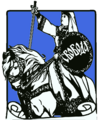 |
Center-left to center-right | The Constitutionalist Party is the product of a political alliance between politicians representing the right wing elements of the pre-Russian Civil War Constitutional Democratic Party or the 'Kadety' and the Union of October 17, or 'Octobrist Party'. In general, the party is known for its support of the Constitution of 1925 and espouses a political ideology characterized by constitutional monarchy and conservative liberalism. | Alexander Guchkov | 19 / 50 |
|
 |
Center-left to center | The Farmer-Labor Party is a Social Democratic party advocating for social security, state control of railways and utilities, subsidies for farmers, and social liberalism. The party frames its economic program as a form of social capitalism and officially denounces communism and socialism as extreme and disproven ideologies. The party is characterized by its populism and is the center of mainstream left wing labor politics in Alaska. While the party does not officially support republicanism, there is a small, quiet republican tendency within the party's ranks. | Dmitri Sokolov | 8 / 50 |
|
 |
Center to center-right | The Party of Russian Pioneers and Farmers (PP&ZR) is the party widely supported by settlers who had arrived in Alaska during and before the Stolypin Reforms and their descendants. The PP&ZR is a socially conservative Christian democratic and agrarian party. The party is catered towards the interests of those who were settled in Alaska prior to the arrival of the White Emigres and supports Farming and Fishing subsidies, infrastructural improvements to smaller towns and rural areas, protectionism and the party also has a large component which advocate for blue laws prohibiting work on Sundays and holy days. In addition to this there is a small, but significant faction within the PP&ZR which are staunch pacifists and prohibitionists. | Demyan Petrikov | 10 / 50 |
|
 |
Center-left | The Progressive Party (PP) is a social liberal party that supports the Constitution of 1925, but advocates for greater protections of freedom of speech and press and advocates for Women's rights, minority interests and religious pluralism. The Progressive Party also supports expanding foreign trade, working with international organizations, improving labor conditions in Alaska, and opposes Communism, Socialism, Fascism and National Socialism. | Aleksandr Konovalov | 6 / 50 |
Political movements in Alaska
{[Work in progress]}
Outline:
Fascists Integralists Absolute monarchists Labor movements Agrarian movements Native autonomy movements Feminist movement American interest groups Other minority interest groups
Political Clubs and Societies
ROVS Octobrist Society More to be added
Illegal Political Movements
Beginning in the late 19th century, certain political movements in Alaska have been deemed seditious due to their advocacy against Russian sovereignty in Alaska or the monarchy. Such movements have been suppressed or banned with varying degrees of strictness in enforcement. The following movements have been banned according to provisions in the Constitution of 1925:
The American Statehood Movement
Beginning in the 1890s amid the Klondike gold rush, a movement in favor of the American purchase or otherwise annexation of Alaska has persisted amongst some Amero-Alaskan quarters of the population. Reaching its zenith around the turn of the century, the movement was suppressed, and protests were broken up by the Alaskan Rangers. Additionally, once the influx of American settlers was offset by settlers from the Russian Empire arriving after the Stolypin Program of 1905 picked up traction in Alaska, the American statehood movement lost much of its numerical strength and Amero-Alaskans became increasingly accustomed to Russian rule. During the first world war, the governorate of Alaska declared the 'Americanist Movement' to be illegal and charged some prominent advocates of American statehood in Novoarchangelsk with sedition, though the subsequent trials concluded with the defendants pleading guilty and signing oaths of loyalty in return for paying relatively small fines.
During the Detrikhs regime, the Americanist movement's ban was expanded to include a ban on any publications or private organizations advocating for the acquisition of Alaska by the United States and harsher punishments were set for the violation of these laws. However, few Americanists were ever charged with sedition during this period, and none were imprisoned.
In 1925, the new constitution cemented the ban on the movement as well as any other movement advocating against Russian sovereignty in Alaska. Since 1925, the movement has seen very little traction and has begun to fade away as a fringe, antiquated movement, especially as mass immigration from Russia has drastically transformed the demographics of Alaska.
Socialist and Communist movements
Though significant labor movements have existed in Alaska dating back to the early mining era in Alaska with small-scale strikes dating back as far as the 1870s, socialism, and communism never caught on significantly in Alaska. During the buildup to the Great War, a small circle of socialists aligning with the Russian Social Democratic Labour Party was founded in Novoarchangelsk in 1909 by Stolypin era arrivals. However, the group was primarily a literary circle and, having limited reach within Alaska and little interest in political agitation, the group was not considered a serious concern. When the Russian Civil War began in 1917, the literary circle was suppressed, and the Governor of Alaska proclaimed an explicit ban on all socialist and communist organizations in the region citing security concerns. The leaders of the circle aligned with the Mensheviks, and after their purge in 1921, the circle formally dissolved.
During the Detrikhs regime, Socialist and Communist agitation was declared a form of treason, and any violators were to face severe repercussions. Members of the circle in Novoarchangelsk were made to disavow socialism and pledge their loyalty to the Russian state, which all but two did. The two who refused were both sentenced to ten to fifteen years in prison for disloyalty to the state.
In 1925, the new constitution re-affirmed the ban on all socialist and communist movements as well as any other movements "hostile to the social order and property rights of the Russian people." Since the new constitution came into effect there have been a few low-profile cases of socialist emigres being sentenced to prison with some being given the option of taking an oath of loyalty to the constitution and the Emperor and Autocrat of all the Russias.
Republican movements
WIP
Political History
List of Heads of State
| Portrait | Name | Reign began | Reigned until | Relationship with predecessor(s) | Title | Notes | |
|---|---|---|---|---|---|---|---|
 Emperor and Autocrat of All the Russias Emperor and Autocrat of All the Russias  | |||||||
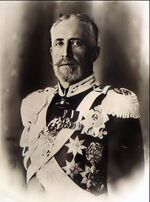
|
Nicholas III | 27th of February, 1925 |
5th of January, 1929 |
• Second cousin of Nicholas II | Emperor and Autocrat of all the Russias | ||
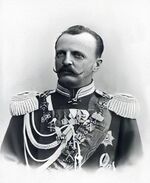
|
Pyotr IV | 9th of January, 1929 | 17th of June, 1931 | • Brother of Nicholas III | Emperor and Autocrat of all the Russias | ||
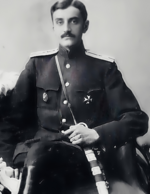
|
Roman I | 27th of June, 1931 | - | • Son of Pyotr IV | Emperor and Autocrat of all the Russias | ||
List of Heads of Government
| No | Portrait | Term | Term | Mandate | Affiliation | ||
|---|---|---|---|---|---|---|---|
| 1 |  Mikhail Diterikhs (1874-) |
1 | 11th of January, 1921 |
17th of May, 1924 |
Succeeded Anton Denikin as head of the White Army in the Russian Far-East | Non-partisan | |
| 1 |  Pyotr Wrangel (1878-1928) |
1 | 17th of May, 1924 |
8th of February, 1925 |
The May Coup d'état | Non-partisan | |
| 1 |  Georgy Lvov (1861-1931) |
1 | 8th of February, 1925 |
20th of March, 1930 |
Majority support from the Provisional Duma | Independent | |
| 2 | 20th of March, 1925 |
20th of April, 1930 |
Progressive-Constitutionalist Coalition Government | Progressive Party | |||
| 2 | 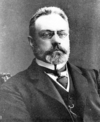 Alexander Guchkov (1862-) |
1 | 20th of April, 1930 |
- | Constitutionalist-Pioneer Coalition Government | Constitutionalist Party | |
Past Elections
National Elections, 1925
National Elections, 1930
Foreign Relations
Soviet Union
Ever since the Governorate of Alaska refused demands of the Soviet Union to submit to Soviet rule, no official relationship has existed between the Soviet Union and Governorate of Alaska. After the restoration of the monarchy in Novoarchangelsk and the settlement of thousands of White Emigres in Alaksa, these cold relations have turned for the worst. The Soviet Union often launches aggressive naval drills off the coast of Alaska and flies planes into the periphery of Alaskan airspace. While such brinkmanship was initially only displayed by the Soviet Union, after the arrival of Wrangel's fleet which had been docket in Bizerte prior to the imperial restoration, the Russian Empire in Exile began conducting its own Naval drills near Soviet waters. Furthermore, after the arrival of Igor Sikorsky and his development of new planes for the White Army Air Corps, the Russian Imperial Air Force was established and Sikorsky's seaplanes have been used extensively in defensive air drills.
The Soviet Union has an official policy stating that Alaska is the sovereign territory of the Soviet Union and is a province in a state of insurrection being propped up by the Capitalist-Imperialist axis of the United States and British Empire. The Soviet Union has in the past assessed measures to inspire tension between native Alaskans and the imperial Russian government in exile but has found very little receptiveness as most of the native population living in close proximity to the White Emigres are practicing Russian Orthodox Christians and the imperial government has seen great success rallying public opinion against the USSR by attacking the state atheism in place in the Soviet Union.
As of 1934, the majority of the world still recognizes the Russian Empire as the legitimate government of Russia, though a growing number of nations have recognized the Soviet Union. The result of limited recognition for the USSR been a considerable diplomatic isolation of the Soviet Union and in sympathetic western media the failures of the Soviet Union are often contrasted by positive stories coming out of Alaska. Most notably, the Russian Empire has declared the recent famines in Ukraine to have been the 'deliberate result of a Red Terror campaign against the Ukrainian people' highlighting what Czechoslovakian publications have dubbed "the Holodomor". Subsequently a bill was introduced to offer Ukrainians fleeing the Holodomor land and agricultural incentives in the Rezanovgrad Agricultural zone.
Japan
United States
Canada
United Kingdom
France
Germany
Czech Republic
Italy
Turkey
Switzerland
Though renowned for its neutrality, Switzerland's opposition to international communism led to their recognition of the Russian Empire in exile in 1926 and financial and diplomatic ties between the two nations have grown ever since. Many prominent White Emigres settled in Switzerland after the Russian Civil War and along with anti-Communists native to Switzerland formed the basis of the International Entente Against the Third International, of which many notable Russian nobles and elites in the Governorate of Alaska are active members. Indeed, Switzerland's favorable treatment of the Russian Empire in exile precedes the official recognition of the country as in 1923, after the attempted assassination of Soviet People's Commissar of Foreign Affairs Georgy Chicherin by Maurice Conradi, himself a Swiss-Russian veteran of Wrangel's Army, Conradi fled to Switzerland where he was defended by Russian-Swiss lawyer and fellow White emigre and future founder of the International Entente Against the Third International, Théodore Aubert, was acquitted of all charges and granted permission to move to the Governorate of Alaska where he rejoined the Russian Imperial Army in-exile.
Finland
International Recognition
The Russian Empire is a member of the League of Nations and widely recognized as the legitimate government of Russia by the Entente and most non-Aligned countries. International recognition is a major component of the Russian Empire's legitimacy and a major component of propaganda proliferated among White Emigres and those sympathetic to the anti-Communist cause in Russia and abroad.
International Organizations
Though recognition of the Russian Empire in Exile is challenged by nations recognizing the Soviet Union, the Russian Empire nonetheless is an acting member in several international organizations and enjoys a strong relationship with various countries and national organizations - especially organizations with an anti-Comintern tendency.
International Entente Against the Third International
Founded by the White Emigre and Swiss native Théodore Aubert...(WIP)
Armed Forces
Army
International Volunteer Corps
The Imperial Russian Navy was founded in 1696 and has operated as the maritime component of the Russian Armed Forces for over three centuries. During its existence, the Imperial Russian Navy saw service in the Russo-Turkish War of 1686–1700, Great Northern War Russo-Persian War of 1722–23, Russo-Swedish War of 1741–1743, Seven Years' War, Russo-Turkish War of 1768–74, Russo-Swedish War of 1788–1790, Russo-Turkish War of 1787–92, Napoleonic Wars, Russo-Turkish War of 1828–29, Crimean War, Russo-Japanese War, World War I and the Russian Civil War. After the defeat of the White Army in Crimea in January of 1921, General Pjotr Wrangel's Fleet (officially the 'Russian Squadron') evacuated from the Black Sea through the Dardanelles and were granted safe harbor by the Third Republic of France in Bizerte, Tunisia.
Wrangel's Fleet remained docked at Bizerte until April pending repairs and several ships were scrapped to afford docking fees before the Imperial Russian Navy successfully lobbied the French and British governments to sponsor its transfer to Novoarchangelsk from which they could aid the White Army in the Russian Far East. The journey to Alaska required stops in Aden, Singapore, Hong Kong, and Busan (with the special permission of the Japanese Empire) before arriving in Novoarchangelsk in late September of 1921.
Ultimately the Imperial Russian Navy could do little to stop the advance of the Red Army until they approached Vladivostok and were able to hold back the Red Army using naval support and conduct a gradual evacuation of civilians in the Russian Far East until December of 1922 when extensive ice made further naval support impossible. Naval Support was impossible until March that year and by then Vladivostok was surrounded. However, in a daring mission, the Imperial Russian Navy was able to once again aid the remaining forces in Vladivostok led by General Anatoly Pepelyayev in one final push to break the siege of Vladivostok and allow for a hastened evacuation of civilians and military forces before the Red Army's final push into Vladivostok secured the city on June 16th of 1923.
After relocating to Alaska, the Russian Navy was greatly aided in adjusting to its new home by the nautical charts and weather data collected over the prior decades by the Alaskan Coast Guard and set to work expanding the military ports at Novoarchangelsk and Rezanovgrad to accommodate the fleet. The large numbers of sailors initially placed a massive strain on the demand for food in Alaska, however, eventually, the economy adapted to the Navy's presence and businesses popped up surrounding naval bases which cater towards sailors and officers. As of 1931, the Imperial Russian Navy (IRN) is the largest military branch in the Russian Armed Forces comprising 12,567 men including officers and sailors. The Russian Imperial Navy is split between its Surface Warfare Fleet, Submarine Squadron, Naval Infantry Division, and Coastal Defense Reserves (not counted in active service numbers).
Surface Warfare Fleet
Submarine Squadron
The Imperial Russian Navy Submarine Squadron is composed of four submarine vessels, the IRN AG-22, IRN Tyulen, IRN Burevestnik and IRN Utka. All formerly a part of Wrangel's fleet, the Imperial Russian Navy Submarine Squadron fields were somewhat outdated but still serviceable submarines. IRN AG-22 is an American Holland-Class submarine designed by the American-Holland torpedo boat company and built for use by the Imperial Russian Navy, whereas IRN Tyulen is a Morzh-class submarine which was constructed at Nikolayev Dockyard and IRN Burevestnik and IRN Utka are both Bars-class submarines designed by Ivan Bubnov and constructed at Nikolayev Dockyard. The Submarine Squadron has adopted the tactics of the Kriegsmarine training to operate as lone wolves and conduct targeted attacks against enemy capital and command ships. The submarines underwent maintenance and minor renovations between 1927 and 1929 before proposals to upgrade the vessels failed to gain support in the Duma. More recently there has been building support within Imperial Navy High Command for an eventual replacement of the current submarine fleet before the end of the decade, with the squadron's commander Counter Admiral Mikhail Berens stating that the current fleet is drawing dangerously to obsolescence if it is not upgraded or, preferably, replaced.
Coastal Defense Reserves
In 1926, facing a significant lack of junior officers' funds were secured for the construction of a campus facility for the Russian Imperial Naval Academy at Novoarchangelsk. Inspired by the Kuznetsov Naval Academy in Saint Petersburg, Russia, the Novoarchangelsk facility was built to mirror the architectural design of the Neoclassical style, albeit on a smaller scale than the original. Where the Academy can claim continuity from its predecessor facility is in its senior officer corps; Mikhail Berens a former Rear Admiral of Wrangel's Fleet serving as its President since its inception. After the building's completion in 1927 the first class to graduate from the facility commissioned as officers in February of 1928. The first class of officers to begin and complete their studies at the naval academy.
===Imperial Russian Air Service===was
Volunteer Flying Corps
Alaskan Home Guard
The Alaskan Home Guard includes its main force of reservists and volunteers who are regular Home Guards, the Alaskan Coast Guard which is a non-military unit responsible for search and rescue operations at sea and maintaining law and order in coastal areas and main waterways, and the Governorate Rangers who act as Alaska's Gendarmerie. At the age of 18, all males in Alaska are required to register for the selective service. Additionally, all 18-year-old men except for those with academic or family exemptions or actively enrolled in a work apprenticeship are required to fulfill two years in the Alaskan Home Guard though are allowed to apply to serve in the Alaskan Coast Guard or Governorate Rangers. In addition, men without academic degrees working in fields not designated as essential to the economy can be called up for periodic reservist training (though with financial compensation) for a period of two to three years to ensure combat readiness. The selective service remains in effect until the age of 42, though in a state of war the draft can be extended to include all males under the age of 48.
Alaskan Coast Guard
The Alaskan Coast Guard began as a collection of free volunteers operating lifeguard stations and rescue vessels during the 1870s as fur trapping brought more pioneers to the Alaskan peninsula. Eventually the Coast Guard was organized into a unified authority during the Dmitry Petrovich Maksutov administration, though it was composed entirely of free volunteers occasionally with the assistance of vessels from the Imperial Russian Navy. Eventually, the Coast Guard was made subordinate to the highest-ranking admiral stationed at Novoarchangelsk in an arrangement that lasted until 1925 when the Coast Guard was transferred to be overseen by civilian local government.
As of 1931, the Coast Guard is the chief maritime component of the Alaskan Home Guard and operates many of the lighthouses and rescue stations across the Alaskan coastline. The Coast Guard is not considered to be a military unit as their operations in coastal law enforcement and search and rescue are critical to the wellbeing of Alaskan society and therefore active-duty Coast Guard sailors are exempted from combat roles. Additionally, the Coast Guard interdicts illegally imported goods, operates radio jamming stations which block Soviet Propaganda from being broadcasted to the Aleutian Islands.
Governorate Rangers
In 1827, the Special Corps of Gendarmes was established in the Russian empire as a military force with law enforcement duties among the civilian population responsible to each respective Governorate. After the nationalization of the Russian American Company in 1867, the security needs of fur trappers, settlers and integrated natives required the establishment of such a body in the Alaska territory and in 1874 the Alaskan Rangers were founded under the Dmitry Petrovich Maksutov administration. The Alaskan Rangers had similar powers to the Special Corps of Gendarmes though these powers were more extensive due to the Alaskan territory being under military rule. Nonetheless, the Alaskan Rangers in effect acted similarly to Canada's North-West Mounted Police which was established a year earlier and primarily served as a regional police force, a check on native particularism and, starting in the 1880s, as a protection force for railroad construction workers.
With the coming of the discovery of gold in Alaska and the succeeding Klondike Gold Rush the Alaskan Rangers were tasked with managing the massive influx of primarily American and Canadian prospectors and those that followed to cater businesses towards them. In 1897, the Alaskan Rangers were instrumental in carefully but forcefully shutting down a massive protest for Alaskan annexation by the United States in Rezanovgrad that threatened to overrun city authorities. Hundreds of Americans were arrested and deported, though some were allowed to stay in the territory in return for paying a fine and signing an oath to follow Russian law and refrain from seditious activities known as the Loyalty Bargain of 1897.
As the Stolypin reforms began in 1905, a wave of thousands of new Russians, Ukrainians and Finns arrived in the Alaskan territory and the Alaskan Rangers were reformed to have a metropolitan and territorial division. The metropolitan division was to be specialized for urban areas defined as having at least one thousand permanent residents while the territorial rangers were primarily tasked with handling native affairs and the protection of the gradually expanding railway system.
After the Russian Civil War, the Russian government and over one hundred thousand White Emigres relocated to Alaska. As the population rapidly expanded throughout the 1920s it became clear that government reform was long overdue. Locally, towns and farming regions had been granted formal local civilian government as early as the 1870s however the region as a whole had been under military rule. After the Governorate of Alaska was established in 1925, the Alaskan Rangers were transferred from military oversight to civilian oversight by the Governorate of Alaska and re-designated as the Governorate Rangers. Over the course of the late 1920s as more towns adopted their own local police forces, the metropolitan rangers have been increasingly confined to operating in frontier towns while the territorial rangers still continue their crucial work engaging in native relations and railway security.
Equipment
Weapons
| Weapon | Picture | Origin | Type | Notes | ||
|---|---|---|---|---|---|---|
| Pistols | ||||||
| Nagant M1895 | 
|
Handgun | Used throughout the Russian Armed Forces and Alaskan Home Guard as service pistol. | |||
| Submachine guns | ||||||
| Thompson Submachinegun | 
|
Submachinegun | Imported from the United States, used by Russian Army and Alaskan Home Guard ground forces. | |||
| Fedorov Avtomat | 
|
Submachinegun | Used by Russian Army and Alaskan Home Guard ground forces. | |||
| Rifles | ||||||
| Mosin Nagant | 
|
Battle Rifle | Used by Russian Army and Alaska Home Guard | |||
| M1903 Springfield Rifle | 
|
Battle Rifle | Imported from United States for hybrid use as standard issue rifle and light marksman rifle. | |||
| Winchester Model 70 | Marksman Rifle | Used by marksmen in Russian Army and Naval Infantry | ||||
| Shotguns | ||||||
| Browning Auto-5 | Shotgun | Used by Russian Special Forces | ||||
| Machine guns | ||||||
| Vickers machine gun | 
|
Medium Machine gun | Used throughout Russian Army and Navy. | |||
| Anti-materiel weapons | ||||||
| Aasen mortar | 
|
Mortar | ||||
| Rosenberg 37mm M1915 | 
|
Support Gun | ||||
Ground Vehicles
| Vehicle | Picture | Origin | Type | In service | Notes | |
|---|---|---|---|---|---|---|
| Armor | ||||||
| Vickers Mark E | 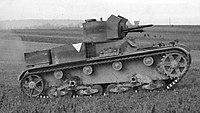
|
Light Tank | 16 | |||
| Renault FT | 
|
Light Tank | 40 | |||
| Vickers Medium Mark II | 
|
Medium Tank | 28 | |||
| Armored Cars | ||||||
| Rolls-Royce Armoured Car | 
|
Armored Car | 16 | |||
| White AM armored car | 
|
Armored Car | 21 | |||
| Alaska-Omsky armored car | 
|
Armored Car | 129 | Produced at the Alaska-Omsky plant in Novoarchangelsk based on White Army designs used for the Fiat-Omsky armored car. | ||
| Austin-Putilov armored car | 
|
Armored Car | 208 | Produced at the Austin Auto manufacturing plant in Novoarchangelsk. | ||
| Armored Carriers | ||||||
| Austin-Kégresse Half Track | 
|
Armored Carrier | 331 | 80 total ordered in 1930, 49 still in production. | ||
| Trucks | ||||||
| Garford-Putilov Armored Truck | 
|
Truck | 11 | Evacuated from Vladivostok towards end of the Russian Civil War. | ||
| Unarmored Vehicles | ||||||
| Ford Model AA | 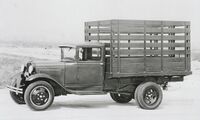
|
Transport Truck | 202 | |||
Watercraft
| Vehicle | Picture | Origin | Type | In service | Notes | |
|---|---|---|---|---|---|---|
| Battleships | ||||||
| Imperatritsa Mariya-class | 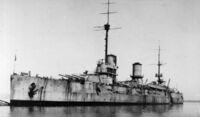
|
Dreadnought | IRN Imperator Aleksandr III | Complement of 1,213. Formerly the IRN General Alekseyev, recomissioned as the IRN Imperator Aleksandr II after the ship was upgraded in 1928. Currently docked at Naval Base Novoarchangelsk. | ||
| Ekaterina II-class | 
|
Pre-Dreadnought | IRN Georgii Pobedonosets | Currently docked at Naval Base Novoarchangelsk. Complement of 642. | ||
| Destroyers | ||||||
| Derzky-class | 
|
Destroyer |
|
Each ship hosts a complement of 125. | ||
| Fidonisy-class | 
|
Destroyer | IRN Tserigo | Complement of 136. | ||
| Tucker-class | 
|
Destroyer |
|
Purchased from the United States in 1927 and upgraded with anti-air armaments. Formerly named the:
| ||
| Admiralty Modified R-class | 
|
Destroyer |
|
Purchased from the United Kingdom in 1927. An eight ship, the HMS Undine was ordered, however was wrecked on Horse Sand Fort en route and subsequently scrapped. Formerly named the:
| ||
| Minesweepers | ||||||
| Kitoboy-class | 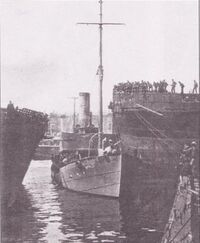
|
Minesweeper | IRN Kitoboy | Complement of 40. | ||
| Hunt-class | 
|
Minesweeper |
|
All purchased in 1927 from within the Aberdare group which were completed in 1917-19. Formerly the:
| ||
| Cruisers | ||||||
| 2nd-class cruiser | 
|
Seaplane tender | IRN Almaz | Carries 4 seaplanes, currently relegated to supporting coastal search and rescue. Hosts a complement of 336. | ||
| Bogatyr-class cruiser | 
|
Protected Cruiser | IRN General Kornilov | Complement of 589. | ||
| Submarines | ||||||
| American Holland-class | 
|
Submarine | IRN AG-22 | Complement of 30. | ||
| Morzh-class | 
|
Submarine | IRN Tyulen | Complement of 47. | ||
| Bars-class | 
|
Submarine |
|
Each hosts a complement of 33. | ||
| Command and Replenishment Ships | ||||||
| Denver-class | 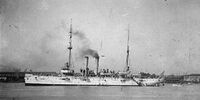
|
Command Ship | IRN Amerika | Converted from US Navy cruiser C-17 USS Galveston after the ship was decommissioned by the United States and sold in 1930. Hosts a complement of 327 (19 officers plus 308 enlisted). | ||
| Arethusa-class | 
|
Oiler Ship | IRN Germes | Formerly the USS Arethusa (AO-7). Hosts a complement of 24 officers and enlistedmen with an auxiliary compliment of 66 civilians (most of which are Navy veterans). | ||
| Kronstadt-class | 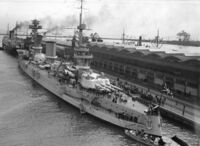
|
Repair ship | IRN Kronstadt | Complement of 120, has a carrying capacity of 2,575. | ||
| Psezuape-class | 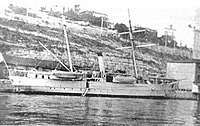
|
Ammunition Ship | IRN Psezuape | Near-obsolete mid-19th century schooner, in need of replacement. Hosts a complement of 52 (7 officers and 45 enlistedmen). | ||
| Hospital Ships | ||||||
| Asturias-class | 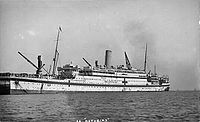
|
Hospital Ship | IRHS Angel | Formerly British operated HMHS Asturias, purchased in 1930. Hosts a complement of 85 (five officers, thirty enlistedmen and 50 nurses. Has a carrying capacity of 1,200. | ||
| Aviso Ships | ||||||
| Yakut-class | 
|
Aviso | IRN Yakut | Hosts a complement of 120. | ||
| Icebreaker Ships | ||||||
| Gaydamak-class | 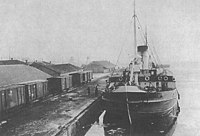
|
Armed Icebreaker |
|
Each hosts a complement of 60. | ||
| Vsadnik-class | 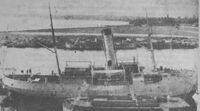
|
Armed Icebreaker | IRN Vsadnik | Hosts a complement of 35. | ||
| Training Ships | ||||||
| Grand Duchess Ksenia Alexandrovna-class | 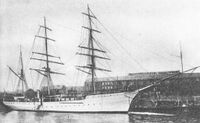
|
Training Barque | IRN Grand Duchess Ksenia Alexandrovna | Used for officer cadets, by procedure carries 8 officers, 16 sailors and as many as 100 cadets. | ||
Aircraft
| Aircraft | Picture | Origin | Type | In service | Notes | |
|---|---|---|---|---|---|---|
| Fixed-wing aircraft | ||||||
| Fokker D VII | 
|
Fighter | 32 | In active service, plans for replacement have existed since 1927. | ||
| Curtiss Falcon | 
|
Fighter | 12 | In active service | ||
| Sikorsky VS-37B "Strazh" | 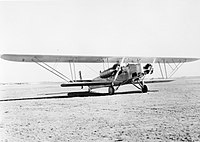
|
Bomber | 27 | In active service, introduced in 1927 and in active production | ||
| Sikorsky R.S. | 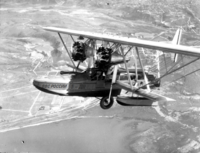
|
Flying Boat | 22 | In active service, introduced in 1928 and in active production | ||
| Nieuport 21 | 
|
Recon | 9 | Primarily used as trainer planes. | ||
| Lebed XIII | 
|
Recon | 41 | In active service. | ||
Demographics
Ethnic Groups
Alaska is comprised of people of many varying ethnicities. In the 1930 census, listed ethnic groups included:
• Russians
• Natives
• Amero-Alaskans
• Finns
• Cossacks
• Japanese
• Filipinos
• Ukrainians
• Canadian-Alaskans
• Yakuts
• Baltic Germans
• Volga Germans
• Jews
Languages
Alaska has established Russian as the official language of the Governorate of Alaska and Russian is exclusively used for government purposes. However, many families and communities in Alaska are bi-lingual, with native languages, English, Japanese, Tagalog, German and Yiddish among others being spoken throughout many large parts of Alaska and even functioning as a majority linguistically in some areas. Among Russian emigres the widespread use of second languages is controversial and advocacy groups exist for restrictions on signage and public events held in foreign languages, however English and native languages likewise are promoted by their own primary users in the country in their push for linguistic recognition.
Religion
The Governorate of Alaska is officially an Orthodox Christian nation and as such moral laws and public holidays exist in keeping with the Orthodox faith. However, Alaska is pluralist in allowing those of other faiths to practice their own faiths so long as doctrines do not contradict Russian or Alaskan law. In recognition for the large Catholic and Protestant section of society, Western Christmas is recognized as a national holiday. After Christians, there exists notable Shintoist and Jewish populations in the country and concentrated in southern urban centers, privately owned Shintoist shrines and synagogues are common.
Economy
Commerce
Industry
Agriculture
Much of Alaska's food stock is provided by foreign aid from the United States of America, Canada, and to a limited extent Japan. Private donations also make up a significant part of this aid.
Domestic production is limited due to the limited arable land available to farmers - the vast majority of food production is performed to the southern-most portions of Alaska, particularly around Rezanovgrad. Fishing is also a major portion of the industry.
Agriculture is diversified during the summer regions - Corn, cucumbers, and tomatoes are examples of some Summer-only crops. The Summer also marks a significant increase in foodstuff production. Year-round crops include potatoes, cauliflower, cabbage, turnips, broccoli, kohlrabi, barley, hay, oats, and brussels sprouts.
Organized Labor
Foreign Trade and Investments
Alaska's largest trading partners are the Dominion of Canada, the United States of America and the Empire of Japan. (WIP)
Transport and Infrastructure
Electrification
In Alaska, electric power does not exist in any meaningful, widely accessible way in rural villages. Most heating and cooking in rural areas is achieved through the use of wood and coal heaters, stoves and ovens and most lighting is achieved through the usage of oil or kerosene lamps. This is not terribly different from northern Canada, however as Alaska has seen its population boom and a gradually increasing number of rural villages it is becoming increasingly important that electrification provide farmers and rural businesses with access to electricity. In larger frontier towns and small cities, electricity is often supplied only to a select few buildings such as schools, churches, post offices and administrative buildings by means of one or several small gas-powered generators. In major cities electrification has come much further along with Novoarchangelsk and Rezanovgrad, Krusensternburg and Lysiansk each having seen private-public partnerships direct investment towards providing electrification to the towns.
Ferries
A crucial part of Alaska's transportation system and domestic commerce, ferries exist connecting all major coastal settlements throughout the country. The publicly operated service connecting Novoarchangelsk to Rezanovgrad and other larger coastal towns is known as the Alaskan Coastal Highway, connect with municipal bus and train services, and during summer months when it is safe for larger ferries to operate, make it possible for those owning cars to travel and commute between major cities. In addition to the Alaskan Coastal Highway, there exist many privately operated ferry companies servicing smaller communities and offering luxury transportation between Novoarchangelsk and Rezanovgrad.
Train lines
Airports
Due to the extreme challenges that Alaska's landscape and climate poses, there are dozens of small domestic airports dotting the many settlements of the country. In addition to these there are three civilian international airports, and four major military airports are operated in Alaska. The three international airports are Novoarkangelsk International Airport, Nicholas III Airport at Rezanovgrad and the smaller Severo-Polyarnyy Airport at Krusensternburg. Additionally, there are plans for the expansion of Baranovsk's domestic airport into a small international airport for the purposes of better servicing the community.
Maritime Ports
Culture
Music
Fashion
Men's Fashion
Women's Fashion
Literature
Media
Press
Radio
Since its first ever introduction to Alaska during the Stolypin Era, Radio has been an integral part of communication in Alaska. First implemented for communication between government authorities as they coordinated the large-scale settlement of Alaska by Russian pioneers. Since the 1920s, Radio has gradually taken off in Alaska and as of 1932, roughly one third of households in Alaska possessed a radio.
National Radio Network
Commercial Radio
Sports
American Football
First introduced to the Alaskan peninsula by Klondikers from the American west coast, American Football grew further in popularity among the Stolypin Era settlers of Novoarchangelsk and Rezanovgrad and, while still limited in scale, the University of Rezanovgrad, the University of Alaska at Krusensternburg, Imperial Academy of the Arts and Sciences at Novoarchangelsk, the University of Novoarchangelsk, the American University at Novoarchangelsk, Polar College at Baranovsk, and Wrangel College at Wrangelgrad each feature college football teams and organize matches between one another.
Hockey
The most prominent sport in Alaska, Hockey took off in Alaska during the 1880s and further grew in popularity throughout the remainder of the 19th century. By the year 1920 an intercollegiate league had grown to be composed of eight teams representing the the University of Rezanovgrad, the University of Alaska at Krusensternburg, the Lutheran College at Krusensternburg, Imperial Academy of the Arts and Sciences at Novoarchangelsk, the University of Novoarchangelsk, the American University at Novoarchangelsk, Polar College at Baranovsk, and Wrangel College at Wrangelgrad. After the National Hockey League was established in Canada in 1917, a lobbying effort began for the NHL to expand into Alaska, though this effort was stalled by Wrangel's 1924 coup. However, after the nation stabilized the lobbying effort resumed and in 1929 after the construction of a stadium in Rezanovgrad, an expansion was officially announced, and the Alaska Nanooks joined the NHL.
Baseball
Wrestling
Mushing
Sled dogs have been used to pull sleds since at least 6000 BC. Dog sleds and harnesses were discovered in Siberia with dog remains carbon-dated to 7800-8000 years old. Dogs were often used to pull loads in Native American cultures and thus dog sledding in Alaska began as a matter of practicality.
Russian settlers had forgone the use of dog sleds and instead used imported Siberian ponies for transportation, as dog sledding was seen as archaic and an inferior mode of transportation. However, during the Klondike, Canadian settlers from Quebec who had adopted the practice during the 17th century brought this skill with them and, after arriving in Alaska in the 1890s became the first Europeans in Alaska to use dog sleds as a primary mode of transportation. American settlers and Stolypin Era pioneers soon began to adopt the practice. The rising popularity of dog sledding was further boosted in 1911, Norwegian explorer Roald Amundsen successfully used sled dogs in a race to become the first person to reach the South Pole. Finally, in 1925, dog sledding ascended to legendary status after Baranovsk and surrounding areas, plagued by diptheria, faced a blizzard that prevented the air delivery of a life-saving serum to Baranovsk airport. Determined to deliver much-needed medicine, the Alaskan Ministry of Internal Affairs dispatched a team of dog sledders who, in a long 1,085 km perilous journey, managed to deliver the medicine within 5 ½ days.
The Iditarod was a landmark event in Alaskan history, with the lead dog of the dog sled team Balto and his musher Gunnar Kaasen both being recognized by Chairman Pyotr Wrangel of the Provisional Government. Kaasen was inducted into the Order of Saint Alexander Nevsky, and a statue depicting Kaasen and Balto were later erected in Novoarchangelsk and Baranovsk.
(WIP)
Cultural Symbols & Icons
List of things to include: Polar Bears Orcas Sea Otters Aviation Gold & Klondike White Army Stolypin Iditarod & Huskies Russian Orthodox Church Igloos
Public Holidays
| Date | English name | Original name | Remarks |
|---|---|---|---|
| January 12 | Christmas Day | Рождество | Christmas according to the Julian calendar |
| January 12 | Prosecutor General's Day | День работника прокуратуры Российской Федерации | Honoring the 1772 foundation of the office of the Prosecutor General of Russia |
| January 14 | Orthodox New Year | День нового года | New Year's day according to the Julian Calendar |
| April 7 | Annunciation | Благовещение | The celebration of the announcement by the angel Gabriel to Mary that she would conceive and bear a son through a virgin birth and become the mother of Jesus Christ, the Christian Messiah and Son of God, marking the Incarnation. |
| April 21 | Local Self-Government Day | День местного самоуправления | Commemorates the reform of 1925 which restructured the Russian Empire and Alaskan Governorate. |
| April 27 | Day of Russian Parliamentarism | День российского парламентаризма |
commemorates the first session of Russia's first-ever State Duma in 1906 |
| May 24 | Saints Cyril and Methodius Day | День святых Кирилла и Мефодия |
Commemorates the 'apostles to the Slavs' St. Cyril and St. Methodius as well as their development of the Cyrillic alphabet. |
| June 6 | Pushkin Day | День Пушкина |
|
| Last Sunday of July | Navy Day | День Военно-Морского Флота | Honoring the active and reserve personnel, heroes and veterans of the Russian Navy |
| August 1 | Day of Remembrance of Russian Soldiers Who Fell in World War I | День памяти российских воинов, погибших в Первой мировой войне 1914-1918 годов | Holiday enacted in1924. |
| August 6 | Russian Railway Troops Day | День железнодорожных войск | Honoring all the active and reserve personnel, heroes, fallen and veterans of the Russian Railway Troops |
| August 12 | Russian Air Force Day | День Военно-воздушных сил | Honoring the active and reserve personnel, heroes and veterans of the Russian Air Force |
| August 19 | Apple Feast of the Saviour | Яблочный праздник Спасителя | Also known as the Feast of the Transfiguration |
| October 1 | Russian Ground Forces Day | День Сухопутных войск | Honors those serving, the heroes, fallen and veterans of the Russian Ground Forces on the day of the raising of the first units of the legendary Streltsy by Ivan the Terrible in 1550 |
| October 17 | Tsar Roman Petrovich Romanov's Birthday | День рождения царя Романа Петровича Романова | Commemorates the Birth of reigning Tsar Roman Petrovich Romanov. |
| October 30 | Day of Remembrance of the Victims of the Red Terror | День памяти жертв политических репрессий | Enacted in 1921, honors the victims of the Soviet Union past and present |
| November 10 | Police and Internal Affairs Servicemen's Day | День сотрудника органов внутренних дел Российской Федерации | Honoring all those serving in the Police of Russia and all those working in the Ministry of Internal Affairs |
| November 27 | Naval Infantry Day | День морской пехоты | Honoring the 1705 date of the raising of the first units of today's Russian Naval Infantry by orders of Peter the Great |
| December 9 | Fatherland's Heroes Day | День Героев Отечества | Anniversary of the 1769 establishment (OS date: November 26) by Catherine the Great of the Order of St. George |
| December 25 | Western Christmas | Западное Рождество | Christmas according to the Gregorian calendar |



